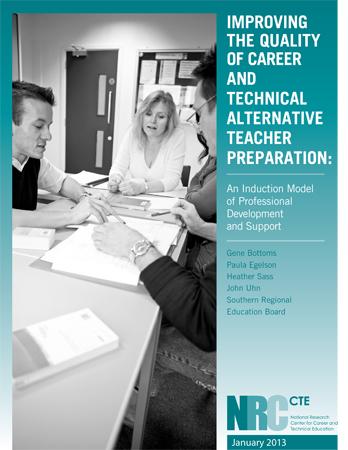NRCCTE Reports
Rigorous Tests of Student Outcomes in CTE Programs of Study: Final Report
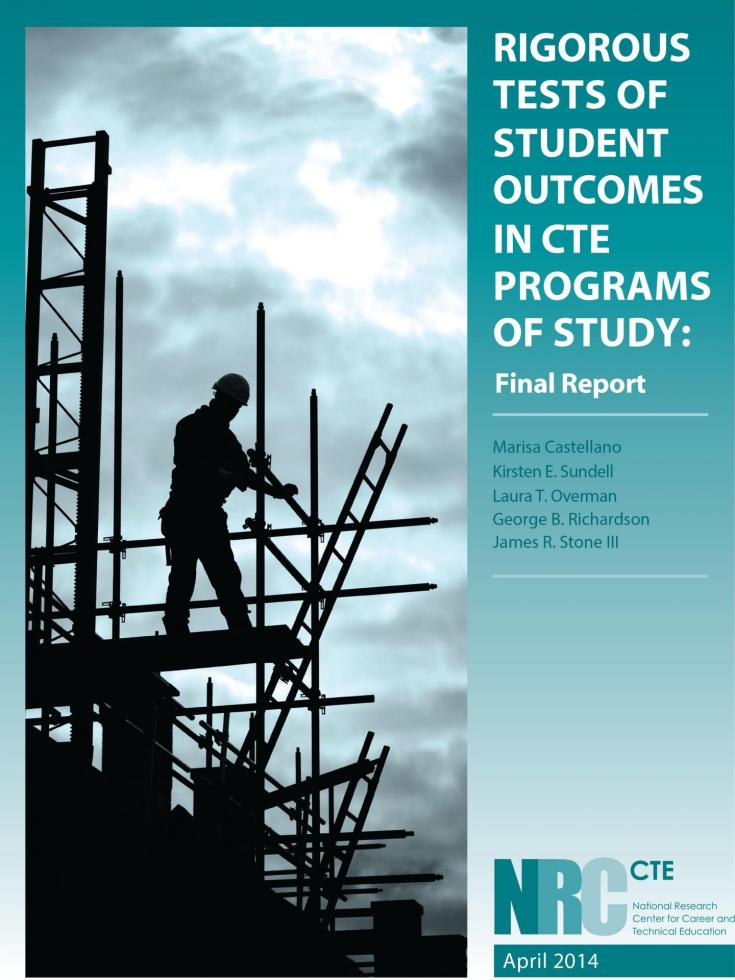 This final report offers findings
from a four-year longitudinal field study of 6,638
students in three large urban school districts in three states.
Researchers Marisa Castellano, Kirsten E.
Sundell, Laura T. Overman, George B. Richardson,
and James R. Stone III followed students from the Class
of 2012 from their ninth-grade year through high school
graduation. Students in the intervention group were enrolled in
programs of study/career pathways, many offered as wall-to-wall
career academies in subject areas ranging from the health
sciences, engineering technology, and alternative fuels to
automotive technology, business and marketing, and culinary and
hospitality. Students in the comparison group attended regular
comprehensive high schools.
This final report offers findings
from a four-year longitudinal field study of 6,638
students in three large urban school districts in three states.
Researchers Marisa Castellano, Kirsten E.
Sundell, Laura T. Overman, George B. Richardson,
and James R. Stone III followed students from the Class
of 2012 from their ninth-grade year through high school
graduation. Students in the intervention group were enrolled in
programs of study/career pathways, many offered as wall-to-wall
career academies in subject areas ranging from the health
sciences, engineering technology, and alternative fuels to
automotive technology, business and marketing, and culinary and
hospitality. Students in the comparison group attended regular
comprehensive high schools.
Career and Technical Education, Career Pathways, And Work-Based Learning: Changes in Participation 1997–1999
We examined the extent to which high school students are choosing to participate in work-related education after a decade of education reform in the United States. Using data from the National Longitudinal Survey of Youth 1997, we first examined the characteristics of students enrolled in alternative curriculum concentrations: career and technical, academic, dual (combining academic and CTE), and general. We then examined the characteristics of students who enroll in career pathways, tech prep, or any work-based learning activity (defined as cooperative education, job shadowing, mentoring, school-sponsored enterprise, and internship/apprenticeship).
Secondly, we analyzed socioeconomic, school experience, and CTE-related variables that could be predictors of participation in curriculum concentrations, career pathways, tech prep, and WBL activities; high school academic achievement; and risky behaviors. We concluded that CTE-related programs, supported by the school reforms, have helped in changing the coursetaking pattern of youth participating in those programs, and significantly contribute to students’ high school achievement.
Oregon Applied Academics Project: Final Report
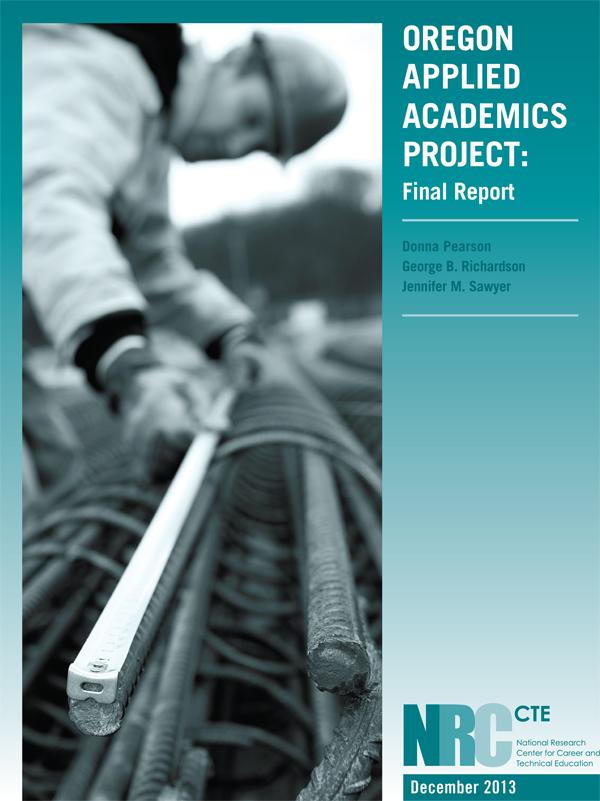 This report contains the findings of
the Oregon Applied Academics research and development project
which spanned three academic years from 2010 through 2013. The
overall purpose of the project was to develop and implement a
technical math course that would meet graduation requirements and
improve student performance.
This report contains the findings of
the Oregon Applied Academics research and development project
which spanned three academic years from 2010 through 2013. The
overall purpose of the project was to develop and implement a
technical math course that would meet graduation requirements and
improve student performance.
Relative Impact of Interventions to Improve Achievement and Retention in Postsecondary Occupational Programs
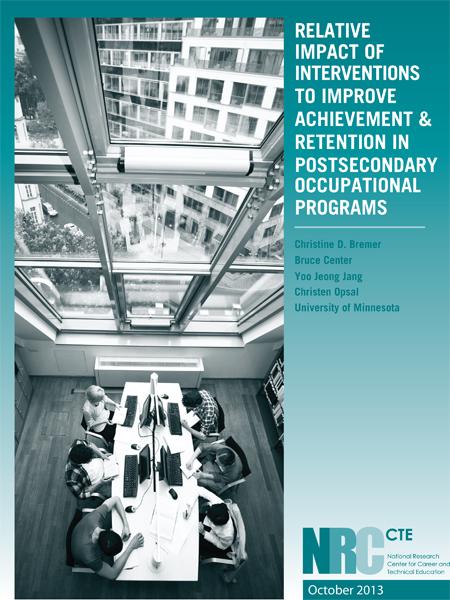 This study examined the relationship
of community college programs and services to retention of
students in four community colleges, with an emphasis on
determining whether outcomes vary for students in occupational
programs and how student characteristics moderate these effects,
with the goal of determining what is correlated with success.
Overall, the study found evidence for positive impacts resulting
from having an occupational major; receiving most types of
financial aid; having higher placement scores, particularly in
math; taking developmental math; accessing tutoring services in
the first term; and choosing an occupational major. White
students were more likely than others to be retained and students
who experienced multiple stressful life events, or who worried
about paying tuition, were less likely to be retained. It was
more useful for students to complete all the credits in which
they enrolled in the first term than to enroll full-time in the
first term.
This study examined the relationship
of community college programs and services to retention of
students in four community colleges, with an emphasis on
determining whether outcomes vary for students in occupational
programs and how student characteristics moderate these effects,
with the goal of determining what is correlated with success.
Overall, the study found evidence for positive impacts resulting
from having an occupational major; receiving most types of
financial aid; having higher placement scores, particularly in
math; taking developmental math; accessing tutoring services in
the first term; and choosing an occupational major. White
students were more likely than others to be retained and students
who experienced multiple stressful life events, or who worried
about paying tuition, were less likely to be retained. It was
more useful for students to complete all the credits in which
they enrolled in the first term than to enroll full-time in the
first term.
Programs of Study as a State Policy Mandate: A Longitudinal Study of the South Carolina Personal Pathways to Success Initiative
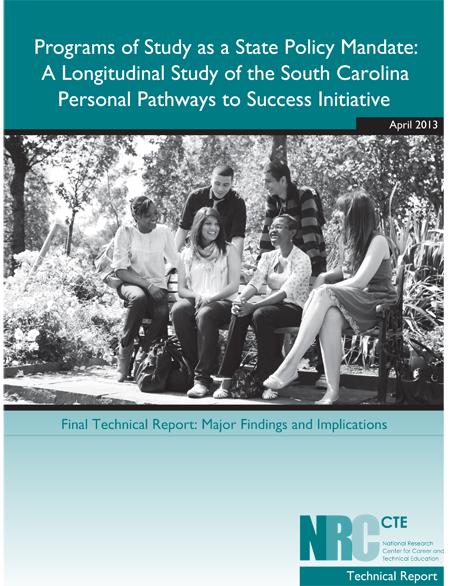 This is the final technical report
from the NRCCTE’s five-year longitudinal study of South
Carolina’s Personal Pathway to Success initiative, which was
authorized by the state’s Education and Economic Development Act
(EEDA) in 2005. NRCCTE-affiliated researchers at the National
Dropout Prevention Center at Clemson University investigated the
extent to which EEDA facilitated the creation of programs of
study/career pathways and whether these programs led to improved
student high school and postgraduation preparation and planning.
The study followed two student cohorts from a sample of eight
high schools from economically and culturally diverse regions of
the state.
This is the final technical report
from the NRCCTE’s five-year longitudinal study of South
Carolina’s Personal Pathway to Success initiative, which was
authorized by the state’s Education and Economic Development Act
(EEDA) in 2005. NRCCTE-affiliated researchers at the National
Dropout Prevention Center at Clemson University investigated the
extent to which EEDA facilitated the creation of programs of
study/career pathways and whether these programs led to improved
student high school and postgraduation preparation and planning.
The study followed two student cohorts from a sample of eight
high schools from economically and culturally diverse regions of
the state.
Mature Programs of Study: Examining Policy Implementation at the Local Level
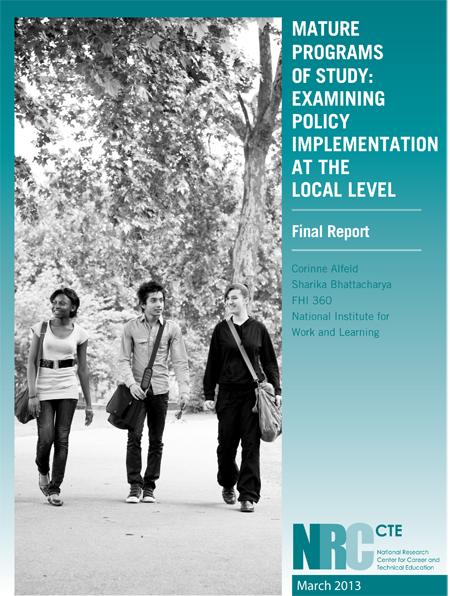 This report presents the final
results of a mixed-method longitudinal study that used
a backward-mapping approach to examine mature, POS-like programs
at three community colleges and their feeder high schools across
the country. This study is part of the NRCCTE’s portfolio
of groundbreaking longitudinal research on POS in the
United States.
This report presents the final
results of a mixed-method longitudinal study that used
a backward-mapping approach to examine mature, POS-like programs
at three community colleges and their feeder high schools across
the country. This study is part of the NRCCTE’s portfolio
of groundbreaking longitudinal research on POS in the
United States.
Work-Based Learning Opportunities for High School Students
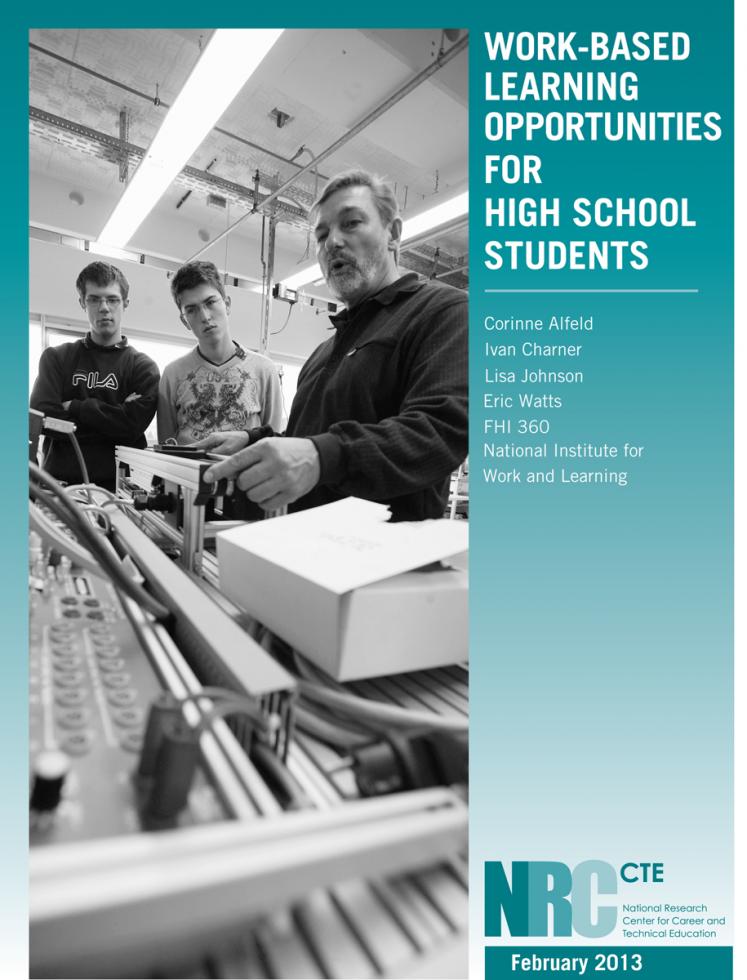 This report prepared by FHI 360
provides a conceptual base for work-based learning (WBL), a
strategy that helps students apply academic and technical skills
and develop employability skills. WBL has been identified as an
important issue for state and local program reform and
implementation, but there is a need to better understand WBL as
part of secondary CTE programs.
This report prepared by FHI 360
provides a conceptual base for work-based learning (WBL), a
strategy that helps students apply academic and technical skills
and develop employability skills. WBL has been identified as an
important issue for state and local program reform and
implementation, but there is a need to better understand WBL as
part of secondary CTE programs.
Improving the Quality of Career and Technical Alternative Teacher Preparation
The Crosswalk Validation Project: Final Report
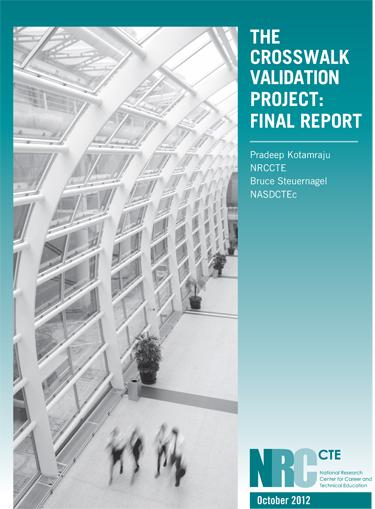 Many of those working in the field
of CTE have continuously grappled with the need for a uniformly
global set of information–a national-level database or, at
minimum, a common, standardized set of definitions and
measures–to meet CTE’s multiple needs, including accountability
and evaluation, career guidance, and program improvement.
Many of those working in the field
of CTE have continuously grappled with the need for a uniformly
global set of information–a national-level database or, at
minimum, a common, standardized set of definitions and
measures–to meet CTE’s multiple needs, including accountability
and evaluation, career guidance, and program improvement.
A Typology for Understanding the Career and Technical Education Credit-Taking Experience of High School Students
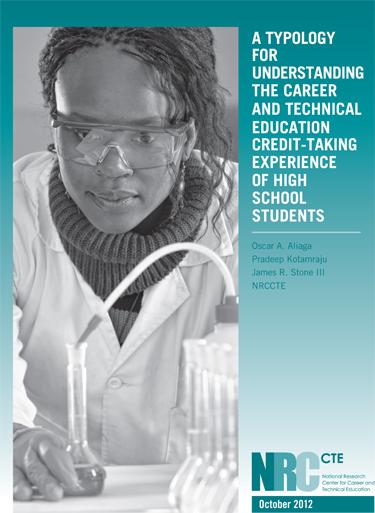 Academic requirements have increased for all high school students in the United States, including those considered CTE students. And research has shown that most students participate in CTE. Acknowledging these facts allows us to better understand the varied nature of students’ high school CTE credit-taking experiences.
Academic requirements have increased for all high school students in the United States, including those considered CTE students. And research has shown that most students participate in CTE. Acknowledging these facts allows us to better understand the varied nature of students’ high school CTE credit-taking experiences.
2007-2012 Impact Report
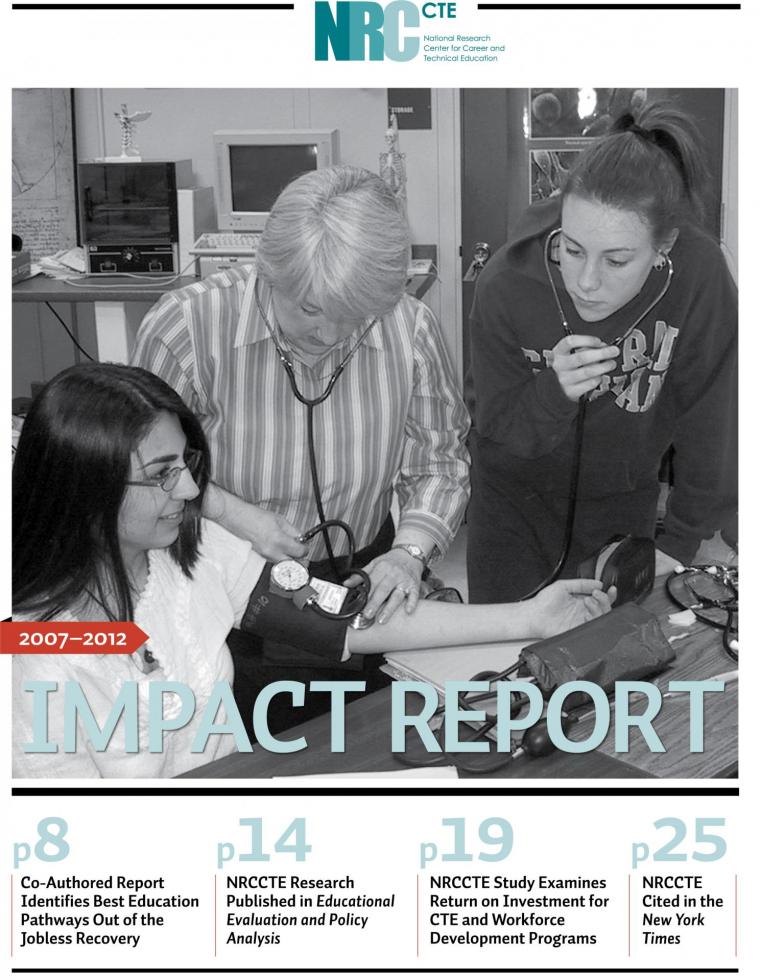 This impact report represents an
executive summary of the research, dissemination, technical
assistance, and professional development activities conducted by
the NRCCTE during its first five years of operation at the
University of Louisville (2007-2012).
This impact report represents an
executive summary of the research, dissemination, technical
assistance, and professional development activities conducted by
the NRCCTE during its first five years of operation at the
University of Louisville (2007-2012).
Additional detail on the NRCCTE’s activities can be found here on our website and in our many published research reports, multimedia products, and formal reports to our funding agency, the Office of Vocational and Adult Education (OVAE) at the U.S. Department of Education, and the United States Congress. This impact statement focuses on how the NRCCTE’s varied agenda has influenced and continues to influence the national discussion of CTE and the contribution CTE can make to improve the high school experience and transition to postsecondary education and employment of young people. In these challenging economic times, CTE is more important than ever to the future outcomes of our youth.
Using Return on Investment and Other Related Tools: Guidelines for Measuring Career and Technical Education Internal Efficiency and External Effectiveness
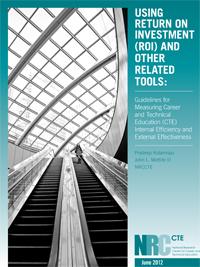 Using Return on Investment and
Other Related Tools: Guidelines for Measuring Career and
Technical Education Internal Efficiency and External
Effectiveness was developed after the NRCCTE received
numerous requests from the field about how to conduct return on
investment (ROI) studies.
Using Return on Investment and
Other Related Tools: Guidelines for Measuring Career and
Technical Education Internal Efficiency and External
Effectiveness was developed after the NRCCTE received
numerous requests from the field about how to conduct return on
investment (ROI) studies.
The report has two major parts. The first describes different approaches to measuring ROI, describes the steps needed to conduct an ROI study of CTE, and provides a basic protocol that the field might adopt when undertaking ROI studies. The second provides summary abstracts of existing ROI studies—organized by state and the organizational level the study targets (e.g., state, system, or project). A series of appendices provide additional information the field might consider when choosing to follow the common protocol in conducting ROI for CTE.
The External Evaluation of the NRCCTE’s Technical Assistance: Green-Focused Programs of Study
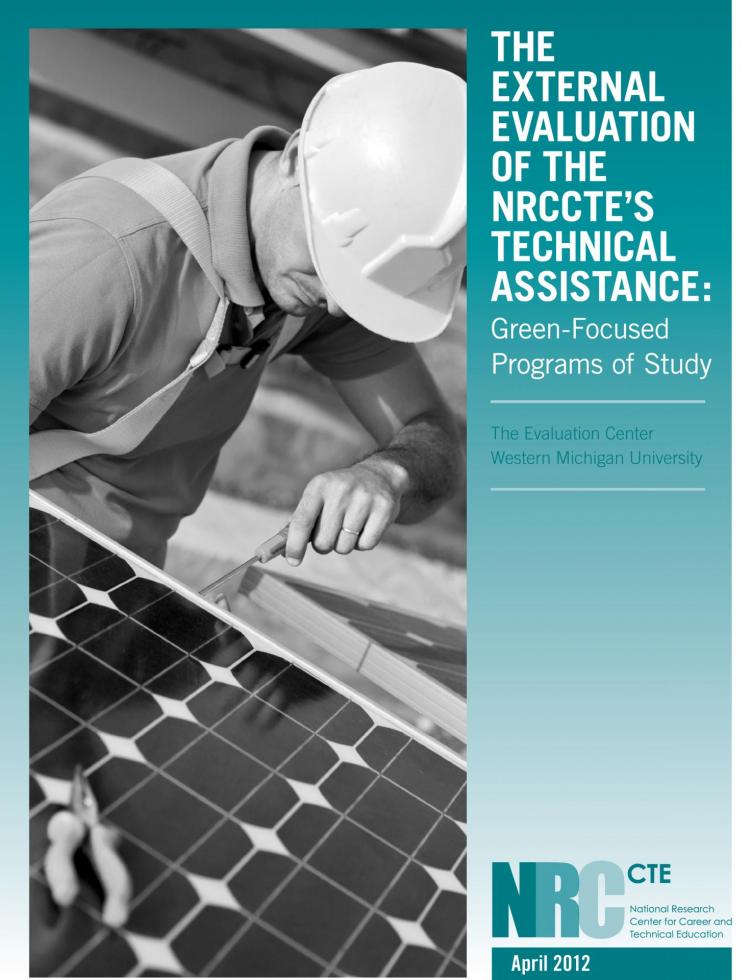 The National Research Center for
Career and Technical Education’s Technical Assistance is intended
to link the NRCCTE’s technical assistance work with practice by
responding to state accountability and program needs related to
the improvement of career and technical education for secondary
and postsecondary students.
The National Research Center for
Career and Technical Education’s Technical Assistance is intended
to link the NRCCTE’s technical assistance work with practice by
responding to state accountability and program needs related to
the improvement of career and technical education for secondary
and postsecondary students.
Implemented by the Academy for Educational Development (now FHI 360), in collaboration with MPR Associates, Inc., the NRCCTE’s technical assistance centered on green-focused programs of study in Georgia, Illinois, New Jersey, Ohio, and Oregon. Specifically, these states received help in developing replicable “POS models that prepare secondary and postsecondary students for high-skill, high-wage, high-demand employment in positions associated with green-focused jobs in any of the 16 Career Clusters, including those aligned with the President’s priorities for green technology in energy, housing, and construction” (NRCCTE, 2010, p. 1).
Career Clusters: Forecasting Demand for High School Through College Jobs, 2008-2018
 Career Clusters: Forecasting
Demand for High School Through College Jobs, 2008-2018, a
joint report co-authored by the NRCCTE in conjunction with the
Georgetown University Center on Education and the Workforce and
NASDCTEc (now AdvanceCTE), identifies 16 career clusters that
represent the full array of related occupational opportunities
and education requirements. Findings show that for those with
high school diplomas, decent jobs still exist but there are not
enough to go around. Only one in three of high school-level jobs
will pay wages of $35,000 or more; although in some cases, with
experience, these jobs can provide up to $50,000.
Career Clusters: Forecasting
Demand for High School Through College Jobs, 2008-2018, a
joint report co-authored by the NRCCTE in conjunction with the
Georgetown University Center on Education and the Workforce and
NASDCTEc (now AdvanceCTE), identifies 16 career clusters that
represent the full array of related occupational opportunities
and education requirements. Findings show that for those with
high school diplomas, decent jobs still exist but there are not
enough to go around. Only one in three of high school-level jobs
will pay wages of $35,000 or more; although in some cases, with
experience, these jobs can provide up to $50,000.
Programs of Study: A Cross-Study Examination of Programs in Three States
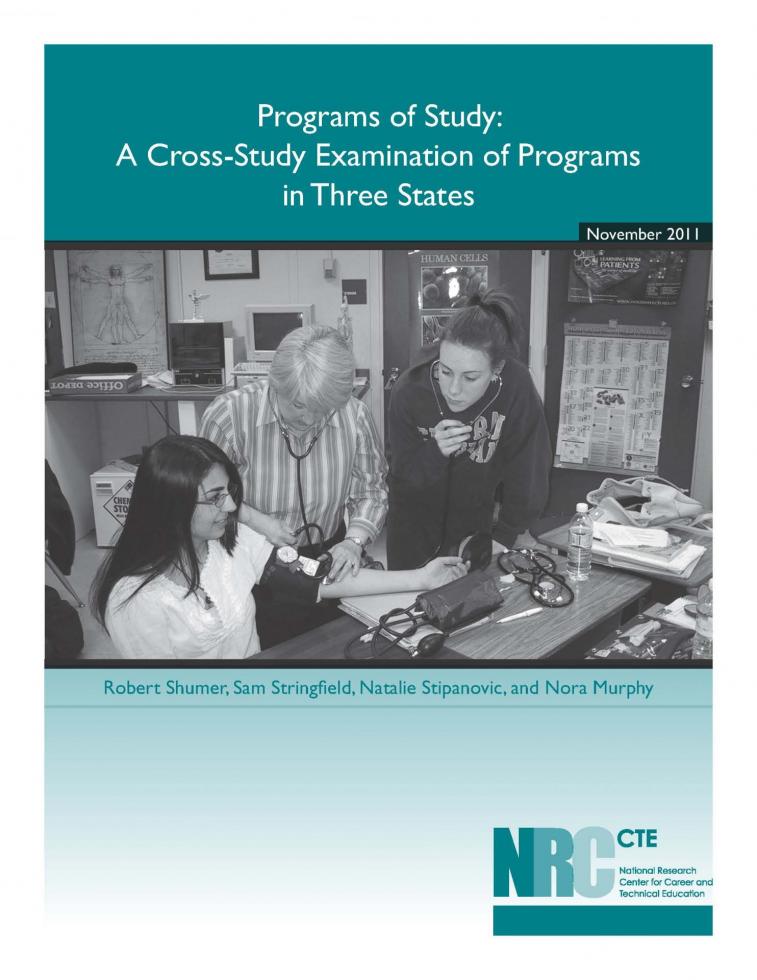 In 2006, Congress enacted the
reauthorization of the Carl D. Perkins Act (also known as Perkins
IV), which changed the name and broadened the scope and purpose
of career and technical education (CTE). The initial charge of
vocational education, established under the Smith-Hughes Act of
1917, was to separate vocational education from academic learning
and focus it primarily on preparation for jobs and employment.
Perkins IV expanded that purpose to prepare individuals for both
college and career, connecting academic learning with job skills
and knowledge and connecting secondary and postsecondary
education. The goal of Perkins IV was to develop a seamless
system allowing all students the opportunity to prepare for work,
college, and life.
In 2006, Congress enacted the
reauthorization of the Carl D. Perkins Act (also known as Perkins
IV), which changed the name and broadened the scope and purpose
of career and technical education (CTE). The initial charge of
vocational education, established under the Smith-Hughes Act of
1917, was to separate vocational education from academic learning
and focus it primarily on preparation for jobs and employment.
Perkins IV expanded that purpose to prepare individuals for both
college and career, connecting academic learning with job skills
and knowledge and connecting secondary and postsecondary
education. The goal of Perkins IV was to develop a seamless
system allowing all students the opportunity to prepare for work,
college, and life.
Programs of Study as a State Policy Mandate: A Longitudinal Study of the South Carolina Personal Pathways to Success Initiative: Year 3 Technical Report
This interim report presents selected preliminary findings from data collection and analysis conducted during the third year of a larger five-year study of South Carolina’s Personal Pathways to Success Initiative by the National Dropout Prevention Center at Clemson University, in conjunction with colleagues from the National Research Center for Career and Technical Education at the University of Louisville. This project is one of three NRCCTE studies that are intended to increase knowledge about Perkins IV-defined Programs of Study and their development, how best to organize a POS to meet the needs of students, parents, schools, and the community, and the impact of POS on student outcomes.
Programs of Study – Year 3 Joint Technical Report
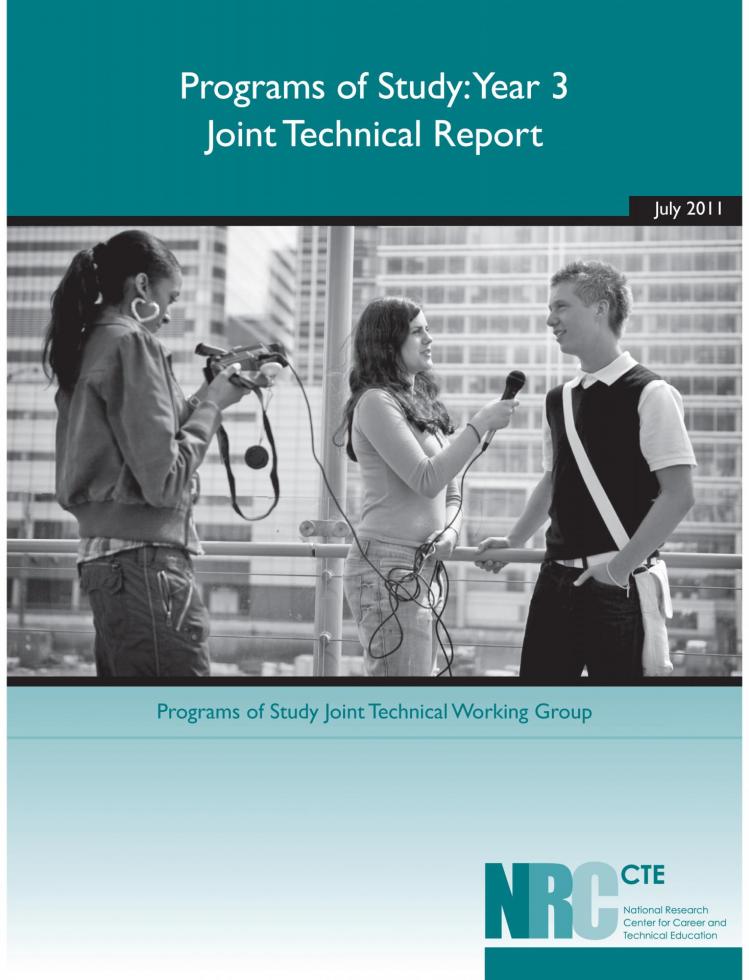 Programs of Study (POS) were the
most significant new requirement in the 2006 reauthorization of
the federal legislation for career and technical education (CTE).
Consequently, the National Research Center for Career and
Technical Education (NRCCTE) established as one of its priorities
the development of information on the operation and effectiveness
of POS. The NRCCTE is conducting four projects that examine POS
from different perspectives. Three are longitudinal studies; due
to the nature of their methodologies, they are at different
stages of implementation. These three studies use some common
data collection methods that allow for comparisons across studies
and use others that are specific to their research questions.
This document comprises the second joint report related to these
three projects and presents their status as of July 31, 2010, the
end of Year 3 of the current NRCCTE cooperative agreement with
the U.S. Department of Education. The first joint report
presented findings and observations derived from the first two
years of these projects (Programs of Study Joint Technical
Working Group, 2010). The fourth project described in this report
was conducted entirely during NRCCTE Year 3. This project used
case study methods to describe how six states were implementing
POS during the first half of 2010, four years after POS had
become part of the federal legislation for CTE. Before discussing
the four projects, we provide some background on how POS came to
be required by Perkins IV.
Programs of Study (POS) were the
most significant new requirement in the 2006 reauthorization of
the federal legislation for career and technical education (CTE).
Consequently, the National Research Center for Career and
Technical Education (NRCCTE) established as one of its priorities
the development of information on the operation and effectiveness
of POS. The NRCCTE is conducting four projects that examine POS
from different perspectives. Three are longitudinal studies; due
to the nature of their methodologies, they are at different
stages of implementation. These three studies use some common
data collection methods that allow for comparisons across studies
and use others that are specific to their research questions.
This document comprises the second joint report related to these
three projects and presents their status as of July 31, 2010, the
end of Year 3 of the current NRCCTE cooperative agreement with
the U.S. Department of Education. The first joint report
presented findings and observations derived from the first two
years of these projects (Programs of Study Joint Technical
Working Group, 2010). The fourth project described in this report
was conducted entirely during NRCCTE Year 3. This project used
case study methods to describe how six states were implementing
POS during the first half of 2010, four years after POS had
become part of the federal legislation for CTE. Before discussing
the four projects, we provide some background on how POS came to
be required by Perkins IV.
Mature Programs of Study: A Postsecondary Perspective – Year 3 Technical Report
There is consensus from many fronts that high schools are not adequately preparing students for college or the workplace. Perkins IV introduced promising legislation to promote programs of study (POS) as one way to address this problem for career technical education (CTE) students. In response to the requirement that Perkins recipients offer at least one POS, many districts have begun to create them. However, research is needed on whether and how POS are benefitting students.
Relative Impact of Interventions to Improve Achievement and Retention in Postsecondary Occupational Programs
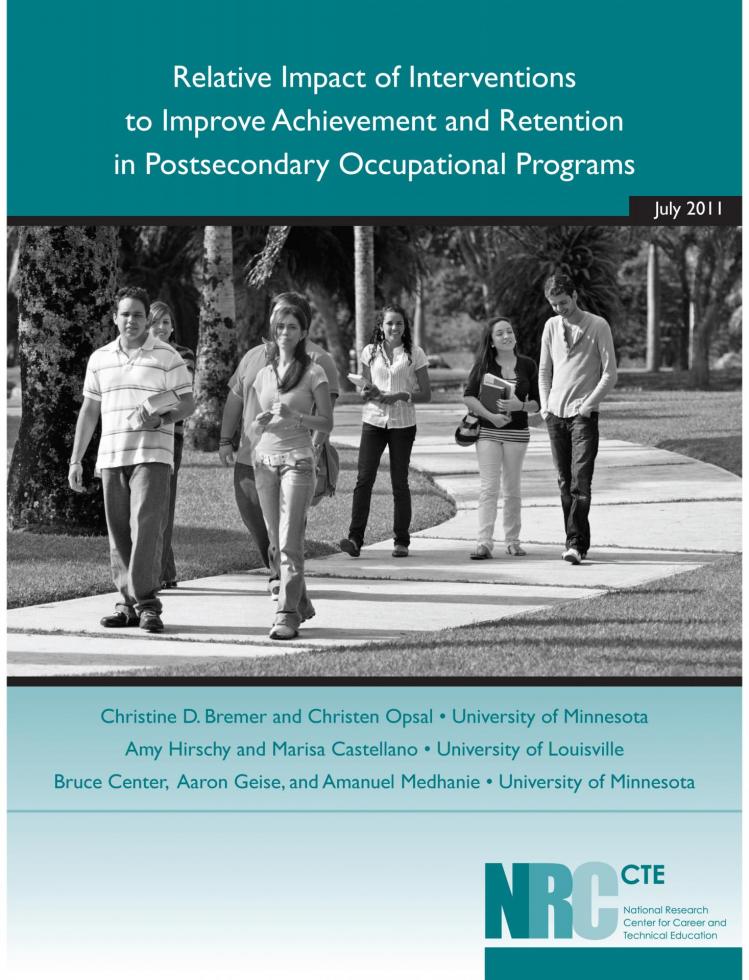 This study seeks to identify which
interventions are most effective in improving retention and
academic outcomes for students in postsecondary occupational
programs, and how student characteristics mediate and moderate
these effects, with the goal of determining what works best for
which types of students. Four community colleges are
participating in the study. This report presents information on
the study purpose, site characteristics, data sources,
retention-related interventions found at two or more sites, data
analysis methods, and early findings. Descriptions of examples of
specific interventions are included and will provide a basis for
determining the comparability of similar programs across sites at
a subsequent point in the study. This report describes project
activities and findings during the period of August 2009 to July
2010. A second cohort of students, those matriculating at the
sites in Fall 2010, has been added to the study and will be
discussed in future reports as data become available.
This study seeks to identify which
interventions are most effective in improving retention and
academic outcomes for students in postsecondary occupational
programs, and how student characteristics mediate and moderate
these effects, with the goal of determining what works best for
which types of students. Four community colleges are
participating in the study. This report presents information on
the study purpose, site characteristics, data sources,
retention-related interventions found at two or more sites, data
analysis methods, and early findings. Descriptions of examples of
specific interventions are included and will provide a basis for
determining the comparability of similar programs across sites at
a subsequent point in the study. This report describes project
activities and findings during the period of August 2009 to July
2010. A second cohort of students, those matriculating at the
sites in Fall 2010, has been added to the study and will be
discussed in future reports as data become available.
Rigorous Tests of Student Outcomes in CTE Programs of Study: Year 3 Report
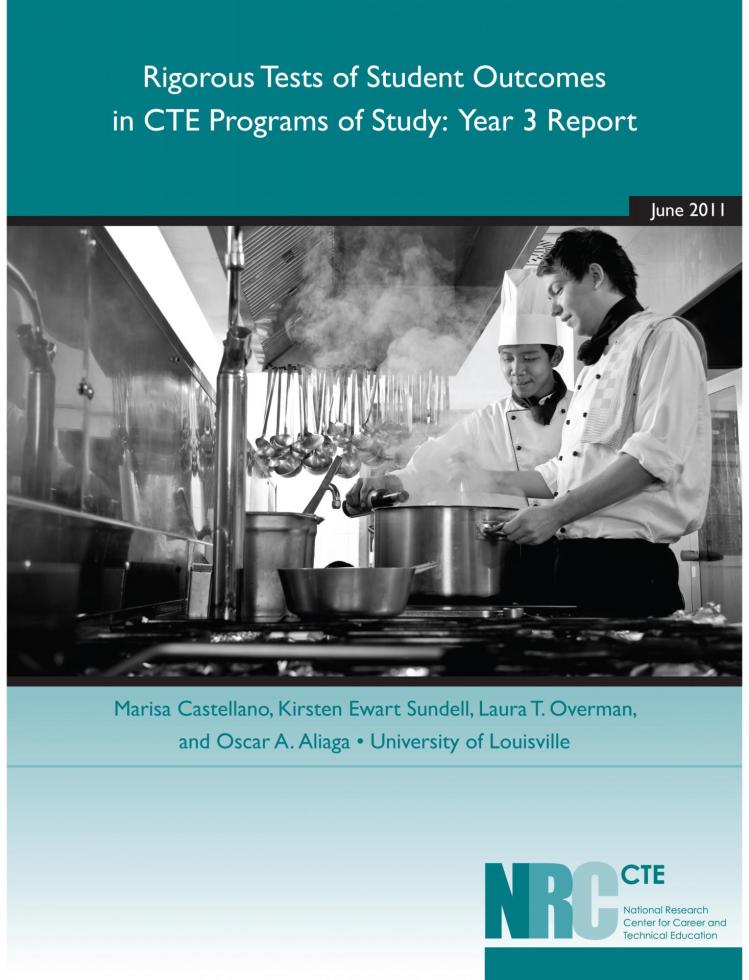 This longitudinal study, currently
in its fourth year, is being conducted in the context of the
reauthorization of the Carl D. Perkins legislation (2006), which
funds career and technical education (CTE) nationwide. The recent
reauthorization, known as Perkins IV, modified existing practice
by increasing program accountability in the areas of academic
achievement, technical skills achievement, and alignment with
postsecondary technical education in the form of programs of
study (POS). The legislation also upheld previous emphases on
serving nontraditional students and those from special
populations (e.g., special education students). The Perkins
mandate sets a high standard, but many states and local education
agencies had already begun to develop programs to achieve these
goals. This study evaluates the impact of this federally mandated
education reform.
This longitudinal study, currently
in its fourth year, is being conducted in the context of the
reauthorization of the Carl D. Perkins legislation (2006), which
funds career and technical education (CTE) nationwide. The recent
reauthorization, known as Perkins IV, modified existing practice
by increasing program accountability in the areas of academic
achievement, technical skills achievement, and alignment with
postsecondary technical education in the form of programs of
study (POS). The legislation also upheld previous emphases on
serving nontraditional students and those from special
populations (e.g., special education students). The Perkins
mandate sets a high standard, but many states and local education
agencies had already begun to develop programs to achieve these
goals. This study evaluates the impact of this federally mandated
education reform.
Six Stories About Six States: Programs of Study
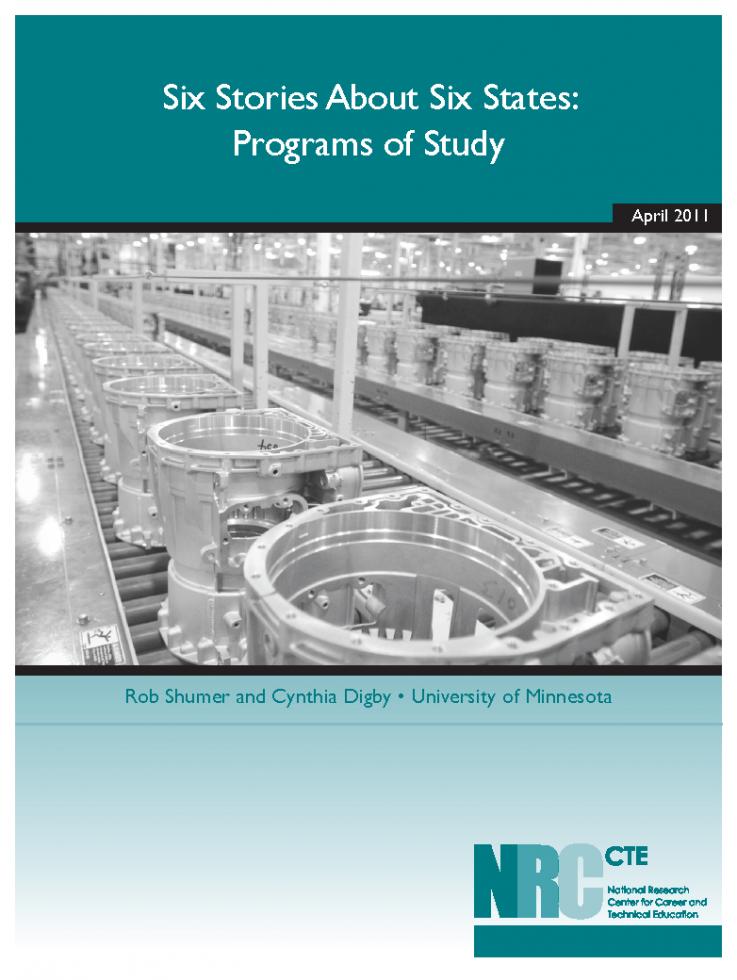 The purpose of this investigation is
to tell the story of how six states are developing Programs of
Study (POS) as mandated by the Perkins IV federal legislation.
Our effort focuses on how states’ technical assistance systems
evolved and what successes and challenges existed for states
developing POS. There was no intent to compare one state with
another; instead, we sought to identify those elements they have
in common and those that are unique to each state. The report
includes profiles of each state, which are located throughout the
United States.
The purpose of this investigation is
to tell the story of how six states are developing Programs of
Study (POS) as mandated by the Perkins IV federal legislation.
Our effort focuses on how states’ technical assistance systems
evolved and what successes and challenges existed for states
developing POS. There was no intent to compare one state with
another; instead, we sought to identify those elements they have
in common and those that are unique to each state. The report
includes profiles of each state, which are located throughout the
United States.
Improving Secondary Career and Technical Education through Professional Development: Alternative Certification and Use of Technical Assessment Data
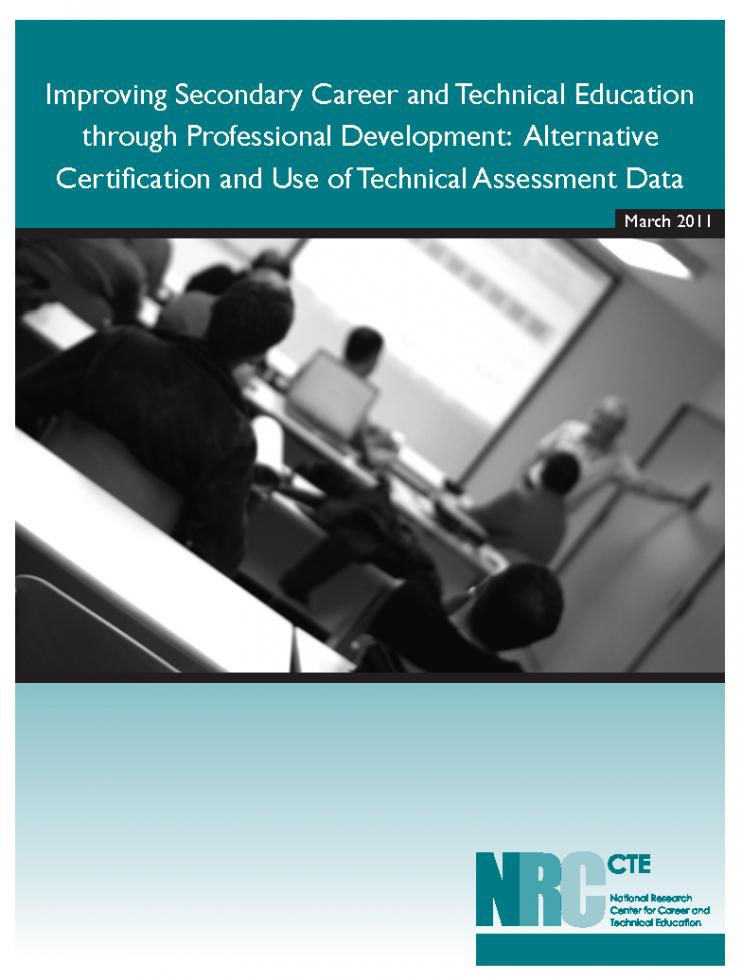 Secondary career-technical education
(CTE) is a field in transition. It is moving from a primary focus
on preparing students for entry-level employment to preparing
them for continuing education and training as well as employment.
The rapid pace of change in technology and the global economy has
created a demand for workers who are able to learn and adapt, and
CTE must prepare its students to meet these demands. Greater
emphasis is being placed on assessment to improve accountability
and to verify students have acquired the skills to undertake
these challenges. These higher expectations come at a time when
more students are taking CTE courses and fewer CTE teachers are
being graduated from teacher education programs. The field has
responded by recruiting more teachers from business and industry,
but those who enter teaching in this way typically have had
little training in pedagogy. Neither these teachers nor many of
their colleagues who have entered through a traditional teacher
education program are prepared to use technical skills assessment
data to help students gain higher levels of competence.
Secondary career-technical education
(CTE) is a field in transition. It is moving from a primary focus
on preparing students for entry-level employment to preparing
them for continuing education and training as well as employment.
The rapid pace of change in technology and the global economy has
created a demand for workers who are able to learn and adapt, and
CTE must prepare its students to meet these demands. Greater
emphasis is being placed on assessment to improve accountability
and to verify students have acquired the skills to undertake
these challenges. These higher expectations come at a time when
more students are taking CTE courses and fewer CTE teachers are
being graduated from teacher education programs. The field has
responded by recruiting more teachers from business and industry,
but those who enter teaching in this way typically have had
little training in pedagogy. Neither these teachers nor many of
their colleagues who have entered through a traditional teacher
education program are prepared to use technical skills assessment
data to help students gain higher levels of competence.
Conducting Return on Investment Analyses for Secondary and Postsecondary CTE: A Framework
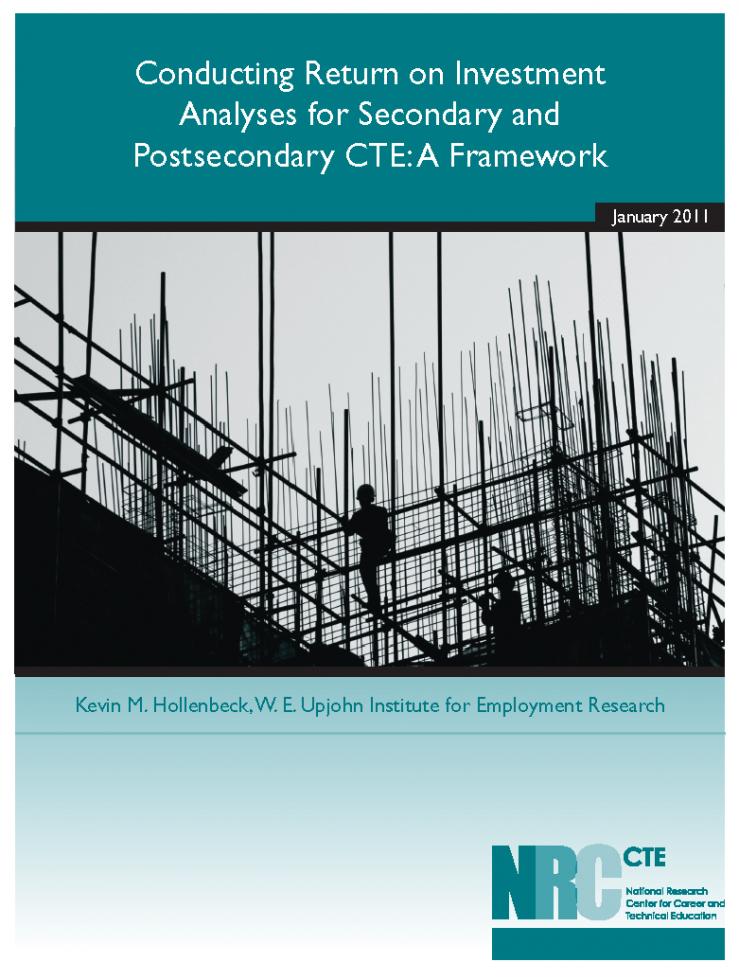 In recent work, Kevin Hollenbeck has
estimated the rate of return for several workforce development
programs in the State of Washington, including secondary and
postsecondary career and technical education (CTE; Hollenbeck,
2008). The returns are based on estimates of the net impact of
CTE on individuals’ labor market experiences and government
income supports after encountering programs. In particular, these
net impacts were estimated using a non-experimental approach that
relies on administrative data sources. The purpose of this paper
is to discuss the estimation approach and to present estimates
for postsecondary and secondary CTE from a recent study. The next
section of the paper discusses net impact estimation, which is
the basis for the rates of return estimates.
In recent work, Kevin Hollenbeck has
estimated the rate of return for several workforce development
programs in the State of Washington, including secondary and
postsecondary career and technical education (CTE; Hollenbeck,
2008). The returns are based on estimates of the net impact of
CTE on individuals’ labor market experiences and government
income supports after encountering programs. In particular, these
net impacts were estimated using a non-experimental approach that
relies on administrative data sources. The purpose of this paper
is to discuss the estimation approach and to present estimates
for postsecondary and secondary CTE from a recent study. The next
section of the paper discusses net impact estimation, which is
the basis for the rates of return estimates.
Technical Skill Attainment and Post-Program Outcomes: An Analysis of Pennsylvania Secondary Career and Technical Education Graduates
 Since the mid-1990s, the
Pennsylvania Department of Education (PDE) has required all
students concentrating in career and technical education (CTE)
programs to complete a standardized technical skill assessment at
or near the end of their program. Results of technical skill
assessments are used for a number of purposes, including
recognizing student achievement, supporting program improvement
and professional development efforts, and holding educators
accountable for their students’ performance. Interest in such
assessments and their use are increasing nationwide, particularly
in response to the 2006 Perkins Act requirement for reporting on
career and technical skill proficiencies (Hyslop, 2009).
Research, however, has yet to fully relate technical skill
levels, as measured by high school graduates’ performance on
broad work readiness or narrow, occupation-specific technical
skill assessments, to their subsequent employment and/or
postsecondary enrollment outcomes.
Since the mid-1990s, the
Pennsylvania Department of Education (PDE) has required all
students concentrating in career and technical education (CTE)
programs to complete a standardized technical skill assessment at
or near the end of their program. Results of technical skill
assessments are used for a number of purposes, including
recognizing student achievement, supporting program improvement
and professional development efforts, and holding educators
accountable for their students’ performance. Interest in such
assessments and their use are increasing nationwide, particularly
in response to the 2006 Perkins Act requirement for reporting on
career and technical skill proficiencies (Hyslop, 2009).
Research, however, has yet to fully relate technical skill
levels, as measured by high school graduates’ performance on
broad work readiness or narrow, occupation-specific technical
skill assessments, to their subsequent employment and/or
postsecondary enrollment outcomes.
Professional Development for Secondary Career and Technical Education: Implications for Change
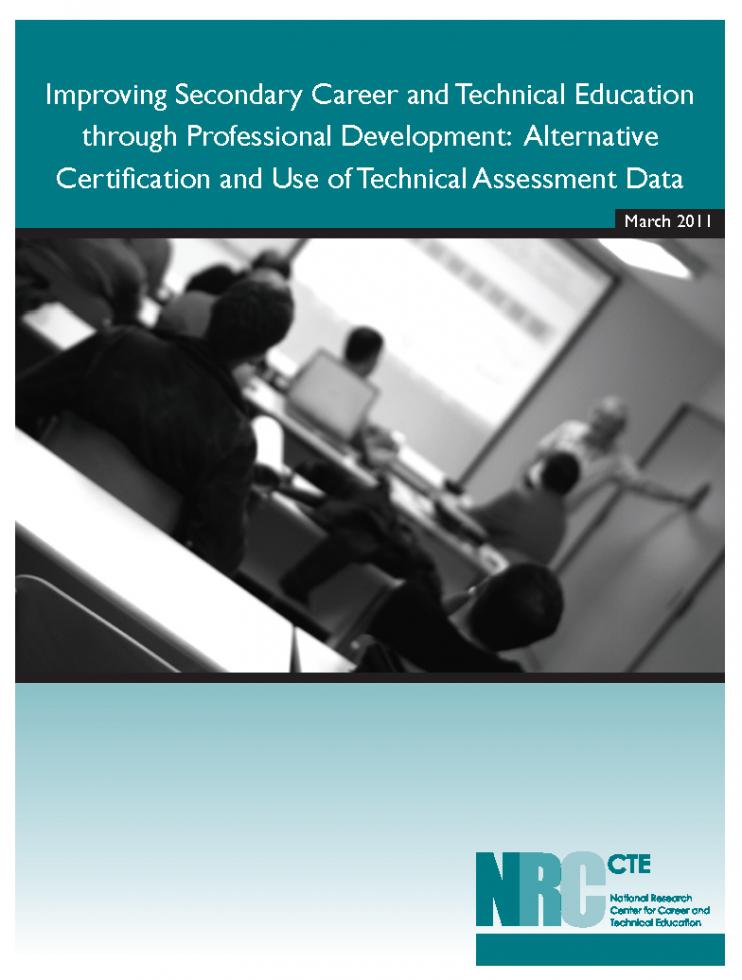 Secondary-level career and technical education (CTE) is broadening its purpose from preparation for entry-level jobs to preparation for both employment and postsecondary education. This expanded purpose requires teachers who have a wider range of skills and knowledge than has been true in the past. This report examines the influences that are creating the context in which professional development for secondary CTE operates, the kinds of learning opportunities that secondary CTE teachers need to respond to this context, and the projects that the National Research Center for Career and Technical Education (NRCCTE) is conducting that are addressing the needs identified. Our focus is on professional development for teachers in the classroom, both those who enter the profession through traditional teacher preparation programs and those who are alternatively certified.
Secondary-level career and technical education (CTE) is broadening its purpose from preparation for entry-level jobs to preparation for both employment and postsecondary education. This expanded purpose requires teachers who have a wider range of skills and knowledge than has been true in the past. This report examines the influences that are creating the context in which professional development for secondary CTE operates, the kinds of learning opportunities that secondary CTE teachers need to respond to this context, and the projects that the National Research Center for Career and Technical Education (NRCCTE) is conducting that are addressing the needs identified. Our focus is on professional development for teachers in the classroom, both those who enter the profession through traditional teacher preparation programs and those who are alternatively certified.
A Common Postsecondary Data Dictionary for Perkins Accountability
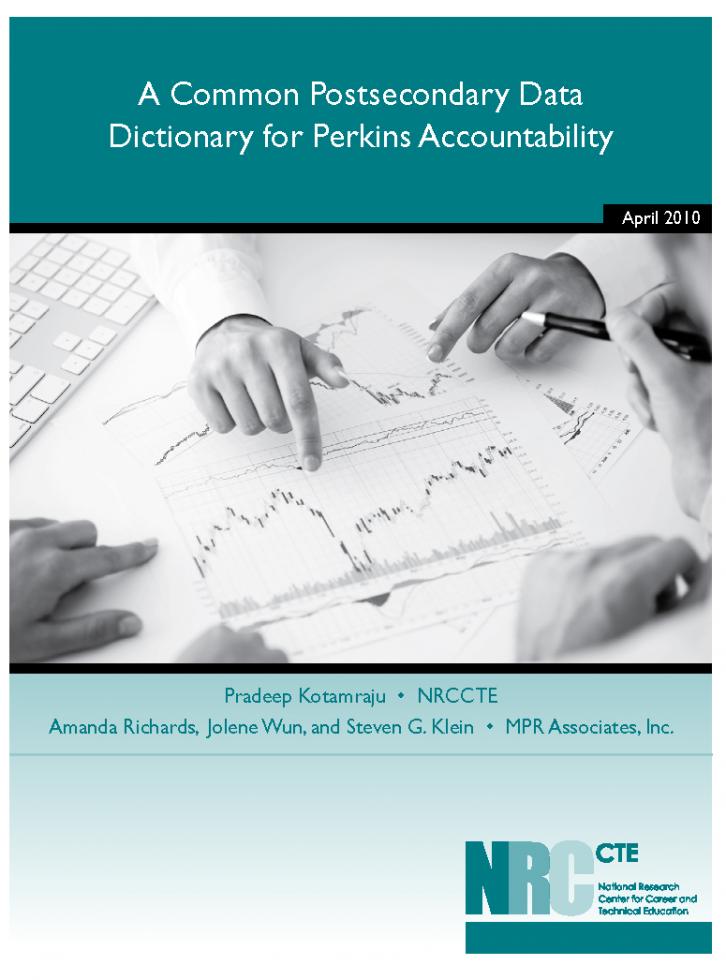 This project assesses the
feasibility of creating a voluntary, nationwide data dictionary
that can be used to standardize the reporting of postsecondary
accountability reporting requirements for the Carl D. Perkins
Career and Technical Education Act of 2006 (otherwise known as
Perkins IV). Variables, field codes, and programming
instructions, defined in collaboration with state postsecondary
data analysts, offer a framework that states can use to crosswalk
data from their existing information systems into a common
database format. In this project, researchers from the NRCCTE and
MPR Associates, Inc., worked together to meet two objectives:
develop a common data dictionary, and perform a quality check on
the data dictionary by asking states to populate it with actual
data.
This project assesses the
feasibility of creating a voluntary, nationwide data dictionary
that can be used to standardize the reporting of postsecondary
accountability reporting requirements for the Carl D. Perkins
Career and Technical Education Act of 2006 (otherwise known as
Perkins IV). Variables, field codes, and programming
instructions, defined in collaboration with state postsecondary
data analysts, offer a framework that states can use to crosswalk
data from their existing information systems into a common
database format. In this project, researchers from the NRCCTE and
MPR Associates, Inc., worked together to meet two objectives:
develop a common data dictionary, and perform a quality check on
the data dictionary by asking states to populate it with actual
data.
Capitalizing on Context: Curriculum Integration in Career and Technical Education
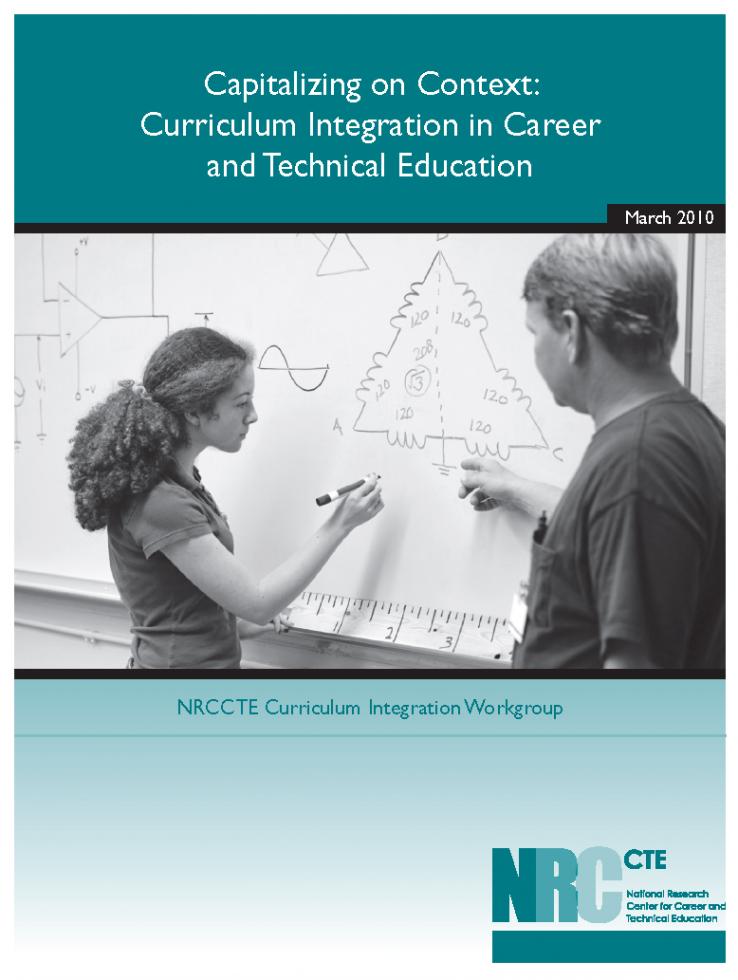 The Math-in-CTE study began as a
pilot in the spring semester of 2004; the full-year study spanned
the 2004-2005 academic year. Volunteer teachers assigned to the
experimental groups worked with math teacher partners to examine
the CTE curricula and develop math-enhanced CTE lessons. The
experimental CTE teachers implemented the math-enhanced lessons
in their classrooms, while the control group teachers taught
their courses without changing their curricula. After one year of
learning math-enhanced lessons, students in the experimental
classrooms performed significantly better on two of the three
standardized measures of math achievement. This result was
accomplished without reducing students’ occupational knowledge
and skills.
The Math-in-CTE study began as a
pilot in the spring semester of 2004; the full-year study spanned
the 2004-2005 academic year. Volunteer teachers assigned to the
experimental groups worked with math teacher partners to examine
the CTE curricula and develop math-enhanced CTE lessons. The
experimental CTE teachers implemented the math-enhanced lessons
in their classrooms, while the control group teachers taught
their courses without changing their curricula. After one year of
learning math-enhanced lessons, students in the experimental
classrooms performed significantly better on two of the three
standardized measures of math achievement. This result was
accomplished without reducing students’ occupational knowledge
and skills.
Authentic Literacy in Career and Technical Education: Technical Appendices to the Spring 2009 Pilot Study
The purpose of this research study was to determine the impact of disciplinary literacy strategies on the reading comprehension and motivation to read for students enrolled in CTE courses. The objective was to compare the effects of literacy strategy instruction under a control condition and two models of content area reading interventions: a CTE framework and the MAX Teaching Framework.
Mature Programs of Study: A Longitudinal Analysis – Year 2 Technical Report
The new legislative requirements for Programs of Study have created a need for information on how best to plan and conduct these programs. A review of state plans for the implementation of Perkins IV found that states planned to draw upon their experience with similar initiatives such as Tech Prep, career pathways, and dual enrollment (Lewis & Kosine, 2008). Because the idea and model for POS in the legislation evolved from CTE reform initiatives such as Tech Prep and career pathways, as described in the NRCCTE Programs of Study Year 2 Joint Technical Report (Programs of Study Joint Technical Working Group, 2009), we recognized that many schools may already be engaged in activities that look very much like POS in spirit, if not in name. That is, POS may have begun with another name but have now been relabeled, if not also restructured, to better fit the new Perkins definition. This study examines the processes and structures of mature sites that (a) have been in existence for several years and (b) have evidence of students moving from a secondary CTE program into a postsecondary CTE program in a nonduplicative sequence of courses, as mandated by Perkins IV.
Online Occupational Education in Community Colleges
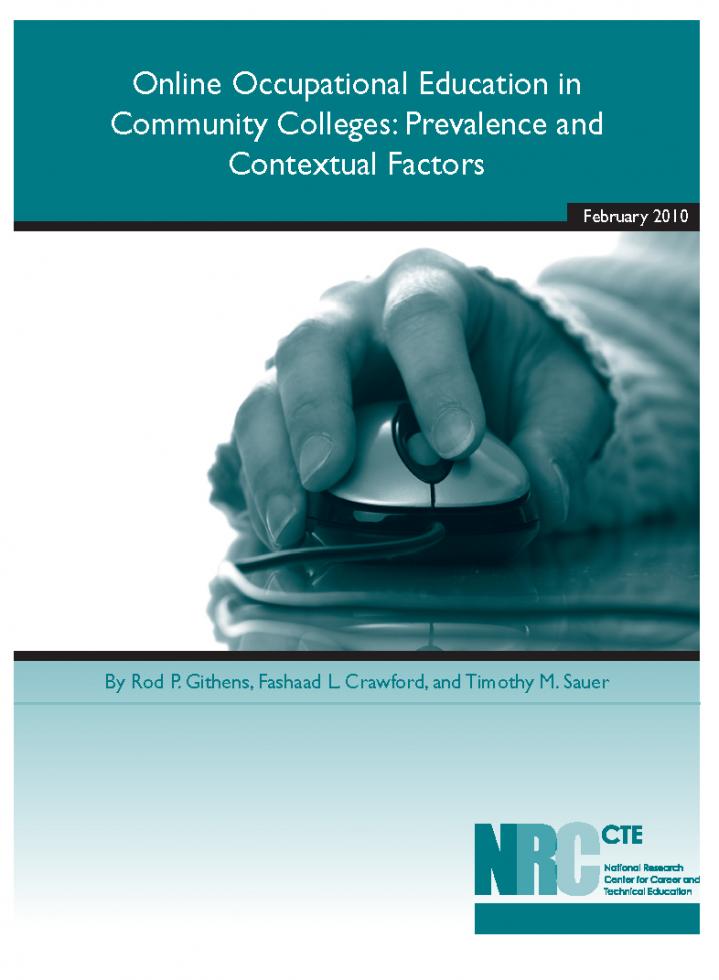 This study examined the current
state of online occupational programs in community colleges and
explored issues related to institutional, economic, and social
indicators that influence (a) the offering of online programs and
(b) the programmatic connection to workforce development needs.
This project is the first national study that categorizes and
inventories specific types of online occupational programs in
community colleges. The study included a national random sample
of 321 institutions in the United States. Data were collected
through institutional websites, statewide websites, follow-up
emails, and phone inquiries to institutions. The following
sections summarize key findings.
This study examined the current
state of online occupational programs in community colleges and
explored issues related to institutional, economic, and social
indicators that influence (a) the offering of online programs and
(b) the programmatic connection to workforce development needs.
This project is the first national study that categorizes and
inventories specific types of online occupational programs in
community colleges. The study included a national random sample
of 321 institutions in the United States. Data were collected
through institutional websites, statewide websites, follow-up
emails, and phone inquiries to institutions. The following
sections summarize key findings.
Programs of Study: Year 2 Joint Technical Report
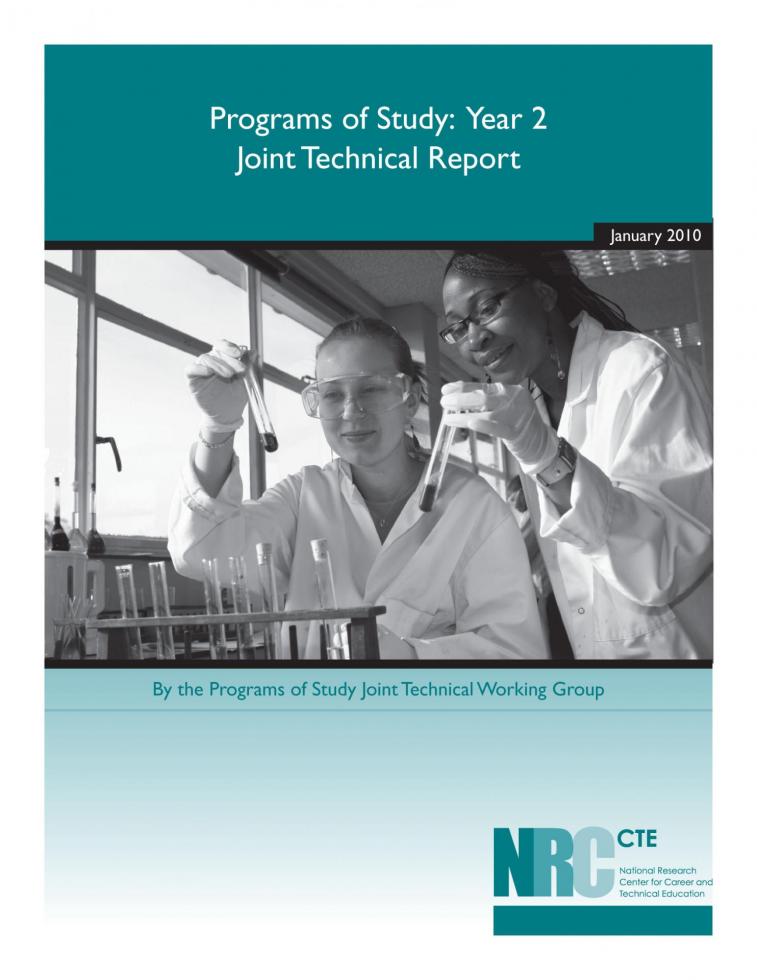 This is a progress report on three
studies being conducted by the National Research Center for
Career and Technical Education (NRCCTE) that examine the
implementation and outcomes of Programs of Study (POS), which
were required in the 2006 reauthorization of the federal
legislation for career and technical education (CTE). The Carl D.
Perkins Career and Technical Education Improvement Act of 2006
(otherwise known as Perkins IV) states that recipients of federal
funds must offer at least one POS that includes coherent and
rigorous content aligned with challenging academic standards and
relevant career and technical content. This content must be
delivered in a coordinated, nonduplicative progression of courses
that align secondary education with postsecondary education and
lead to an industry-recognized credential or certificate at the
postsecondary level or an associate or baccalaureate degree. In
addition, POS may include the opportunity for secondary students
to participate in dual or concurrent enrollment programs or other
ways to acquire postsecondary education credits.
This is a progress report on three
studies being conducted by the National Research Center for
Career and Technical Education (NRCCTE) that examine the
implementation and outcomes of Programs of Study (POS), which
were required in the 2006 reauthorization of the federal
legislation for career and technical education (CTE). The Carl D.
Perkins Career and Technical Education Improvement Act of 2006
(otherwise known as Perkins IV) states that recipients of federal
funds must offer at least one POS that includes coherent and
rigorous content aligned with challenging academic standards and
relevant career and technical content. This content must be
delivered in a coordinated, nonduplicative progression of courses
that align secondary education with postsecondary education and
lead to an industry-recognized credential or certificate at the
postsecondary level or an associate or baccalaureate degree. In
addition, POS may include the opportunity for secondary students
to participate in dual or concurrent enrollment programs or other
ways to acquire postsecondary education credits.
Year 1 Technical Report: Rigorous Tests of Student Outcomes in CTE Programs of Study
The objective of this study is to evaluate the impact of programs of study, a federally mandated education reform that was part of the Carl D. Perkins Career and Technical Education Improvement Act of 2006 (otherwise known as Perkins IV), the legislation that funds career and technical education nationwide. This study seeks to measure the impact of POS on student academic and technical achievement. We are conducting this evaluation using two methodologies. First, we are conducting a set of randomized controlled trials in three sites in one large district. The second test of student outcomes uses rigorous quasi-experimental methods in another large district. Following Perkins law, the measures of effectiveness of POS include: (a) academic achievement, (b) technical skills achievement, c) high school completion, (d) placement in postsecondary education, work, or the military, (e) program participation and completion by nontraditional students, and (f) program participation and completion by students from special populations as defined by the law. In order to better understand student outcomes, the study also describes the context and practices that produced them.
Systematic Reviews of Research: Postsecondary Transitions – Identifying Effective Models and Practices
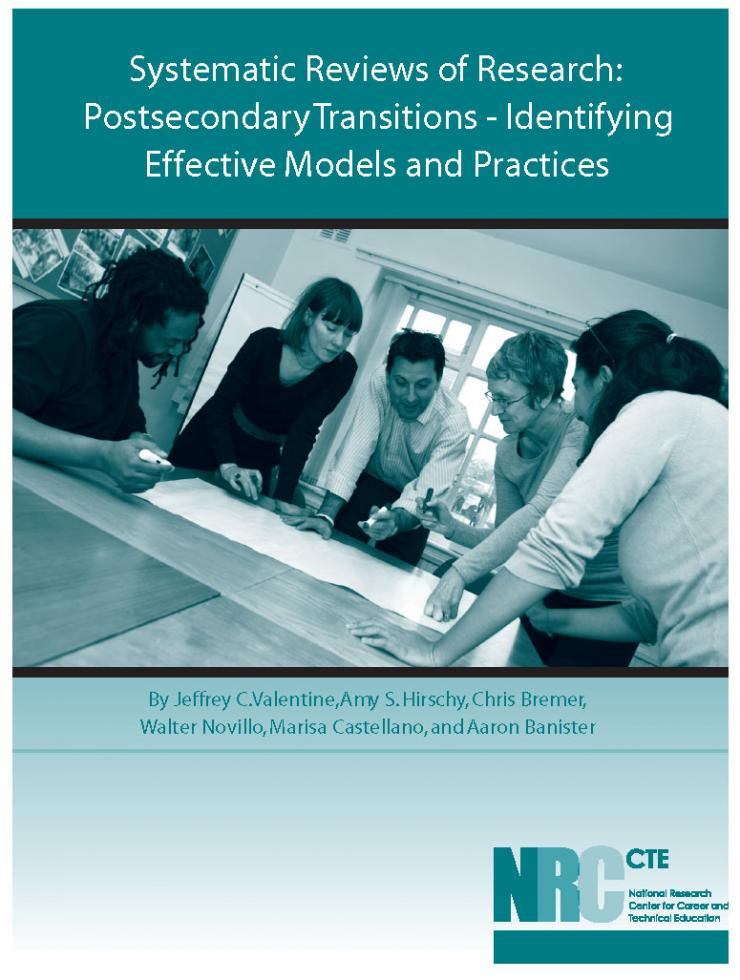 This paper focuses on transition programs for youth to postsecondary education, broadly considered. We address the following questions: (a) What models or programs of transition exist? (b) On what basis can we say one transition program is more effective than another? In other words, how is successful transition defined? c) How are transition models and programs evaluated? and (d) What is the impact of transition programs, specifically those that aim to facilitate transition from one educational system to another, to program completion, or to specific career-related employment for disadvantaged youth?
This paper focuses on transition programs for youth to postsecondary education, broadly considered. We address the following questions: (a) What models or programs of transition exist? (b) On what basis can we say one transition program is more effective than another? In other words, how is successful transition defined? c) How are transition models and programs evaluated? and (d) What is the impact of transition programs, specifically those that aim to facilitate transition from one educational system to another, to program completion, or to specific career-related employment for disadvantaged youth?
Community College Access and Affordability for Occupational and Non-Traditional Student
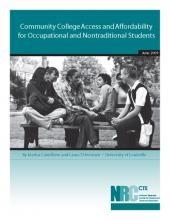 The purpose of this study was to
examine what types of initiatives exist to increase access to and
affordability of postsecondary education, especially in community
college programs that lead to occupational advancement. We
reviewed community college agency and state legislative Web sites
to discover what initiatives or policies are currently being
implemented or considered in the 50 states. We found few
state-level initiatives designed specifically for occupational
students, so we broadened our target population to include
nontraditional students, whom we defined as financially
independent working adults (over 25) who commute to a community
college part time. We found that common ways of attempting to
increase access for nontraditional students were (1) evening and
weekend course schedules, (2) distance learning, and (3)
awareness campaigns about college and the availability of
financial aid. In terms of affordability, we found that states
were expanding existing financial aid programs as well as
creating new ones that target nontraditional students. States
were also targeting specific occupational fields for aid in order
to develop the workforce needed in that state. Future research in
this area should study the effectiveness of these initiatives and
policies in order to determine which initiatives have had the
greatest impact on increasing access to and affordability of
community colleges for occupational and nontraditional students.
The purpose of this study was to
examine what types of initiatives exist to increase access to and
affordability of postsecondary education, especially in community
college programs that lead to occupational advancement. We
reviewed community college agency and state legislative Web sites
to discover what initiatives or policies are currently being
implemented or considered in the 50 states. We found few
state-level initiatives designed specifically for occupational
students, so we broadened our target population to include
nontraditional students, whom we defined as financially
independent working adults (over 25) who commute to a community
college part time. We found that common ways of attempting to
increase access for nontraditional students were (1) evening and
weekend course schedules, (2) distance learning, and (3)
awareness campaigns about college and the availability of
financial aid. In terms of affordability, we found that states
were expanding existing financial aid programs as well as
creating new ones that target nontraditional students. States
were also targeting specific occupational fields for aid in order
to develop the workforce needed in that state. Future research in
this area should study the effectiveness of these initiatives and
policies in order to determine which initiatives have had the
greatest impact on increasing access to and affordability of
community colleges for occupational and nontraditional students.
What Will Be the Impact of Programs of Study? A Preliminary Assessment Based on Similar Previous Initiatives, State Plans for Implementation, and Career Development Theory
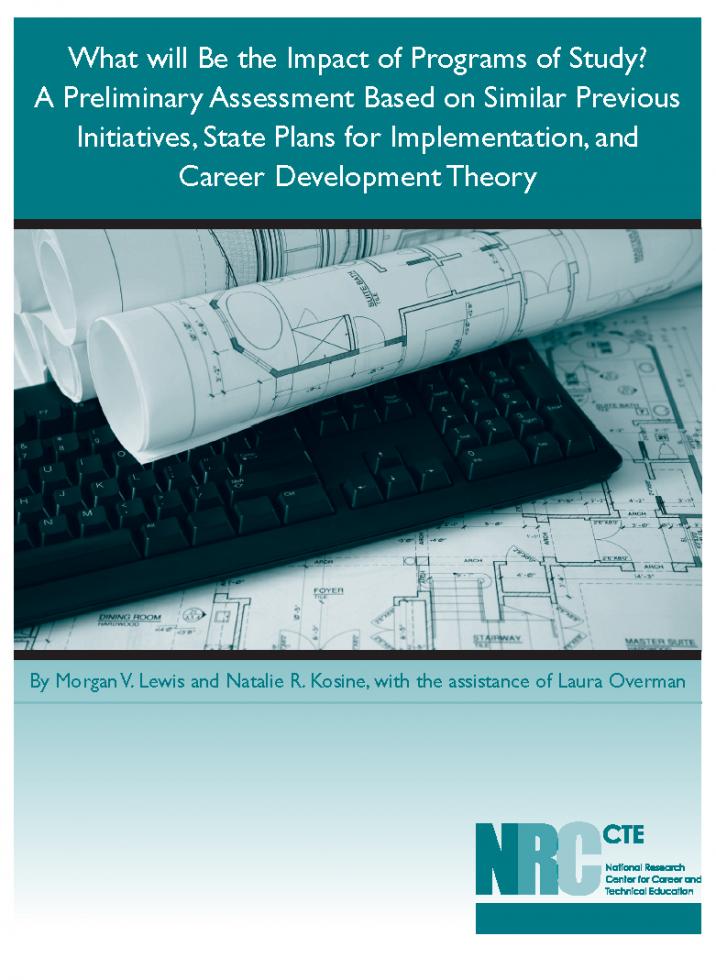 In 2006, Congress reauthorized the
federal role in career and technical education (CTE) by passing
the fourth version of the legislation carrying the name of Carl
D. Perkins. This legislation included the requirement that to be
eligible to receive funds, recipients must offer at least one
Program of Study (POS), which must include coherent and rigorous
content aligned with challenging academic standards and relevant
career and technical content. This content must be delivered in a
coordinated, nonduplicative progression of courses that align
secondary education with postsecondary education and lead to an
industry-recognized credential or certificate at the
postsecondary level or an associate or baccalaureate degree. In
addition, the programs may include the opportunity for secondary
education students to participate in dual or concurrent
enrollment programs or other ways to acquire postsecondary
education credits. In this paper, we provide a perspective on POS
and the effect they are likely to have on the delivery and
outcomes of CTE.
In 2006, Congress reauthorized the
federal role in career and technical education (CTE) by passing
the fourth version of the legislation carrying the name of Carl
D. Perkins. This legislation included the requirement that to be
eligible to receive funds, recipients must offer at least one
Program of Study (POS), which must include coherent and rigorous
content aligned with challenging academic standards and relevant
career and technical content. This content must be delivered in a
coordinated, nonduplicative progression of courses that align
secondary education with postsecondary education and lead to an
industry-recognized credential or certificate at the
postsecondary level or an associate or baccalaureate degree. In
addition, the programs may include the opportunity for secondary
education students to participate in dual or concurrent
enrollment programs or other ways to acquire postsecondary
education credits. In this paper, we provide a perspective on POS
and the effect they are likely to have on the delivery and
outcomes of CTE.
Study of State Certification/Licensure Requirements for Secondary Career and Technical Education Teachers
Teacher preparation in vocational/career and technical education has a rich history dating back to the Smith-Hughes Act of 1917, which first defined qualifications for individuals involved in teaching in this field. Historically, there have been two pathways to teacher certification and licensure in career and technical education (CTE). The first follows a traditional teacher preparation model, using colleges and universities with degree programs consisting of general education, technical content, and teacher pedagogy, including student teaching. The second pathway, an alternative to the traditional model, relies more on work experience in the discipline in which certification/licensure is sought. These dissimilar pathways have co-existed for nearly 100 years.
State Secondary CTE Standards: Developing a Framework out of a Patchwork of Policies
Many state educational administrators are currently working to define secondary career and technical education (CTE) content standards that specify the knowledge and skills students are expected to master in CTE program areas. The two-phase project on which this report is based explored (a) the progress and status of states in developing statewide secondary CTE standards systems, and (b) whether and how teachers are using those standards in their CTE courses. In 2006, an exhaustive query of CTE standards systems across the 50 states and the District of Columbia was conducted using publicly available information, validated through targeted follow-up interviews with state officials. The results include a snapshot description of each state’s secondary CTE standards system as of fall 2006 and the relationship between that system and other standards systems in that state (e.g., secondary academic standards, postsecondary technical standards). For the second phase of the project, the research team selected states with well-developed statewide standards systems and interviewed state-selected CTE teachers about whether having CTE standards has changed how they teach. The results of the second phase show that these teachers welcomed CTE standards. We describe some of the ways that teachers are using these standards in their practice.
Career-Based Comprehensive School Reform: Serving Disadvantaged Youth in Minority Communities
High school engagement and achievement were measured using attendance, dropout, course-taking, and graduation data. High school transition was measured using responses to a senior survey, participation in Tech Prep and dual credit opportunities, and achievement data for the graduates who attended their local community college. All measures were compared to the comparison school students.
A Cross-Case Analysis of Career Pathway Programs that Link Low-Skilled Adults to Family-Sustaining Wage Careers
In recent years, access to community colleges has stretched beyond its initial conception in the 1960s when most community college students were traditional-age learners who sought to transfer to a four-year college or pursue career preparation to enter the workforce. Today, nearly half of the nation’s college students enroll in community colleges in which the student body is equally or more diverse than the communities in which they reside, where the average age of students is over 25, where students enroll in non-credit coursework and stop in and out routinely, where the preponderance of students are unemployed or working in low -wage jobs, and where an ever-growing proportion of these students are immigrants and English language learners (ELLs). Recognizing these trends, scholars have argued that community colleges should con-tribute to an equity agenda that enhances educational and economic opportunity for low-skilled learners. Career pathways can serve as a primary means of meeting low-skilled learners’ needs by systematically linking disparate education and training systems using the community college as the nexus for partnerships and program delivery.
The Postsecondary Achievement of Participants in Dual Enrollment: An Analysis of Student Outcomes in Two States
Dual enrollment programs enable high school students to enroll in college courses and earn college credit. Once limited to high-achieving students, such programs are increasingly seen as a means to support the postsecondary preparation of average-achieving students. Moreover, though dual enrollment programs typically have been reserved for academically-focused students, increasing numbers of career and technical education (CTE) programs are providing such opportunities to their students.
Sustaining the Impact: Follow up of Teachers Who Participated in the Math-in-CTE Study
During the 2004-2005 school year, the National Research Center for Career and Technical Education conducted a study entitled Building Academic Skills in Context: Testing the Value of Enhanced Math Learning in Career and Technical Education, commonly referred to as the Math-in-CTE study. This was a random-assignment experiment that tested the effects of enhancing instruction in the mathematics inherent in the curricula for five occupational areas. Post-testing found that students of teachers who had been in the experimental group scored significantly higher than students of teachers who had been in the control group on two standardized tests of mathematics achievement: 9% higher on TerraNova and 8% higher on Accuplacer. These higher scores were the result of professional development that brought career and technical education (CTE) and mathematics teachers together to examine CTE curriculum and develop lessons that delivered explicit instruction in the math concepts inherent in the technical content. The CTE teachers taught these lessons in their regular classes, devoting an average of about 20 hours or 11% of one traditional, 180-hour, full-year class.
Community College Noncredit Occupational Programming: A Study of State Policies and Funding
This study inventoried state policies and regulations on and financial support for noncredit occupational programming offered by community colleges. Information collected from state- and community college-level administrators and Web-based searches is organized by a range of issues related to noncredit occupational programming and funding, such as definitions for noncredit; categories of noncredit courses; development and delivery of programming, including content standards, instructor qualifications, and noncredit-to-credit course transfer; state-level collection of noncredit programming data; state funding mechanisms for noncredit courses; and contract training. The study also lays the groundwork for further research on the impact of community college noncredit programming policies and funding on course availability and accessibility, business and industry partnerships, and reporting mechanisms and data systems for noncredit programming.
Moving Beyond the GED: Low-Skilled Adult Transition to Occupational Pathways at Community Colleges Leading to Family-Supporting Careers – Research Synthesis
This review of research is part of a larger project which identified exemplary community college programs that employ innovative curriculum and instructional practices in order to help low-skilled adults attain a family sustainable wage. The project goal was to identify best practices that are replicable at other community colleges. These programs and models combine Adult Basic Education (ABE), General Educational Diploma (GED), and sometimes English as a Second Language (ESL) programs with the opportunity to attain postsecondary credentials leading to gainful employment at a family sustainable wage. The project involved three universities and was part the National Research Center for Career and Technical Education funded by the Office of Adult and Vocational Education, U.S. Department of Education. This review of the research was a first step in that project and summarizes what is currently known about low-skilled adults and programs for them.
State Approval Policies and Procedures for Postsecondary Career and Technical Education
This study examined the final program approval for new postsecondary Career and Technical Education (CTE) programs and program review policies and procedures for existing programs based on publicly available Web sites and on follow-up interviews with representatives in the final state approving agency. The purpose of the study was to inventory the various state-level policies and procedures and examine how occupational standards were being incorporated into approval processes.
Looking Inside the Black Box: The Value Added by Career and Technical Student Organizations to Students’ High School Experience
In addition to hands-on learning in classrooms and work-related activities such as co-op, many CTE programs offer a career-focused student organization, known as a Career and Technical Student Organization, or CTSO. CTSOs have been touted as developing such characteristics as leadership and employability skills in students; however, there is little research definitively showing the benefits of participation in CTSOs. In this study, we hypothesized that CTSOs provide a variety of experiences that either directly or indirectly affect three important outcomes of secondary education: achievement, transition to postsecondary education and training, and employability. A pretest/posttest comparison study of high school students in CTE classes that included a CTSO, CTE classes without a CTSO, and general non-CTE classes such as English and social studies was conducted over the course of one academic year. Findings showed that, on a variety of measures, CTSO students began the school year with similar or higher scores than the other groups of students and did not change (gain or lose) as much as did the other groups over the course of the year. With the exception of college aspirations—where students in the general classrooms reported the highest levels—the scores of the CTSO students remained higher than those of students in the other two groups on all measures.
Rigor and Relevance: A Model of Enhanced Math Learning in Career and Technical Education
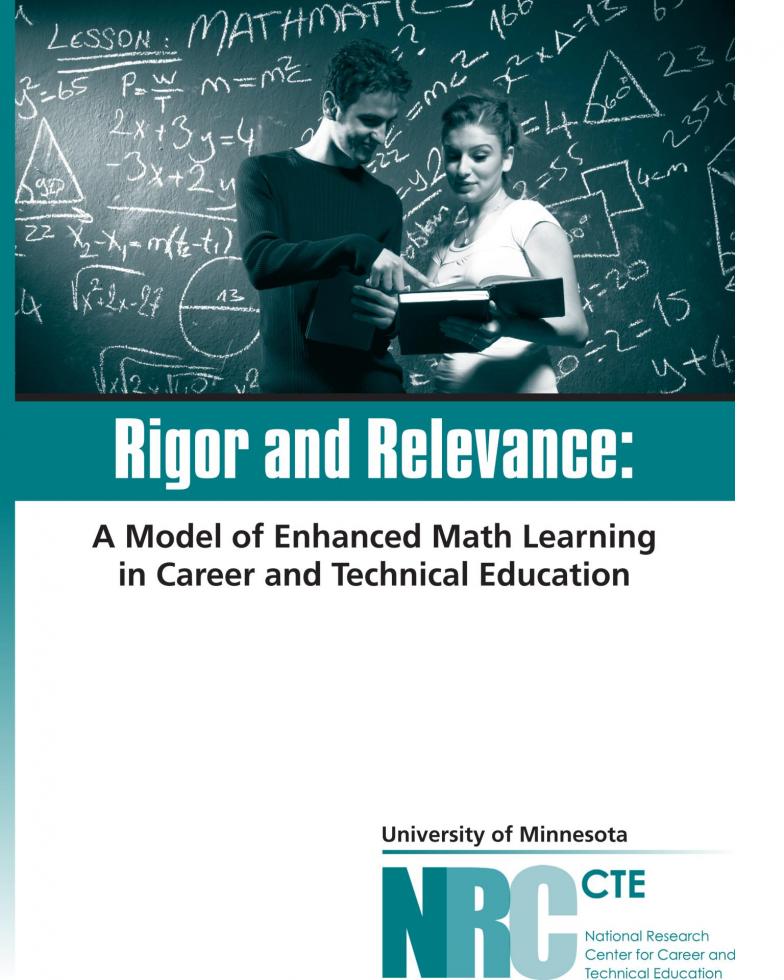 Many high school students,
particularly those enrolled in career and technical education
(CTE) courses, do not have the math skills necessary for today’s
jobs or for college success. This report describes a research
study designed to test a model for enhancing mathematics
instruction in high school CTE courses. A seven-element pedagogy
was designed to move CTE students gradually from a contextual
understanding of mathematics to a more abstract understanding
such as that required on many standardized tests.
Many high school students,
particularly those enrolled in career and technical education
(CTE) courses, do not have the math skills necessary for today’s
jobs or for college success. This report describes a research
study designed to test a model for enhancing mathematics
instruction in high school CTE courses. A seven-element pedagogy
was designed to move CTE students gradually from a contextual
understanding of mathematics to a more abstract understanding
such as that required on many standardized tests.
Volunteer CTE teachers from five occupational areas were recruited and randomly assigned to an experimental or control group. In a series of professional development workshops, the experimental CTE teachers worked with math teachers to examine the CTE curricula and identify the embedded mathematical concepts. The teams then developed instructional activities that the CTE teachers used to enhance the teaching of math that already existed (but was previously not emphasized) in the CTE curricula.
Building Academic Skills in Context: Testing the Value of Enhanced Math Learning in CTE
Many high school students, particularly those enrolled in career and technical education (CTE) courses, do not have the math skills necessary for today’s jobs or college entrance requirements. Math is found in all areas of CTE, but is largely implicit to both teachers and students. This report describes a group randomized trial (GRT) research study designed to test a model for enhancing mathematics instruction in high school CTE courses emphasizing the mathematics that is already embedded in the CTE curriculum. The aim was to help CTE teachers make mathematics more explicit in a meaningful context and then help reinforce students’ mathematics understanding both in and out of that context.
Does Career and Technical Education Affect College Enrollment?
Using the National Longitudinal Survey of Youth 1997 (NLSY97) and its transcript component, we examine vocational education (now known as career and technical education, or CTE) for a recent cohort of youths. We describe and distinguish between CTE coursetaking and participation in particular career-related programs of courses and activities (career majors, Tech Prep, and work-based learning programs such as job shadowing and cooperative education). We find that the majority of American high school students participate in CTE courses and work-related activities, and this holds across demographic subgroups. Black students participate in career-related programs at higher rates than any other group, while males and females participate at similar rates. Students in the lowest income quartile are the least likely to report participation in career-related programs and activities, but the most likely to take proportionately more career and technical education courses than academic ones. Students who scored in the bottom half of the ASVAB Arithmetic Reasoning test distribution are also more likely to take high ratios of CTE-to-academic courses. We find that while participation in career-related programs does not generally impede college attendance, higher ratios of CTE-to-academic courses are associated with reductions in the chances of college attendance, even after adjusting for selection characteristics often associated with course trajectories.
Dropping Out of High School and the Place of Career and Technical Education: A Survival Analysis of Surviving High School
Data from the National Longitudinal Survey of Youth 1997 are used to examine the association between the CTE-to-academic-coursetaking ratio and the likelihood of dropping out. Descriptive statistics are presented for 1,628 individuals born in 1980. Transcript and survey data are then used in estimating nonproportional hazards models with time-varying covariates for a subsample of 846 youth. The research found a highly significant curvilinear effect of the coursetaking ratio on the likelihood of dropping out for youth who were less than 15 years old upon entering 9th grade. For them, a CTE:academic course ratio of 1:2 was beneficial. For youth who were 15 or older upon high school entry, factors other than coursetaking predicted their high rates of dropping out.
Building Academic Skills in Context: Testing the Value of Enhanced Math Learning in CTE Pilot Study
This report describes the conduct and outcomes of an experimental pilot study conducted in Spring 2004 to develop and test a model that aimed to enhance career and technical education (CTE) instruction with the mathematics that is already embedded in the curricula of six occupational areas.
Math is abundant in the CTE curriculum, but it is largely implicit to both teachers and students. The impetus for the study is that many high school students, particularly those in enrolled in CTE courses, do not have the math skills necessary for today’s jobs or college entrance requirements. This research project was aimed at using an authentic context for teaching math skills. Preparation for the study began in the summer of 2003 with the nationwide recruitment of teacher-participants. CTE teachers who were interested in participating were required to identify teachers of mathematics who was willing to work with them during the course of the study. From a total of 274 CTE teachers who applied to participate, 114 were randomly assigned to and participated in the experimental group, whereas the other 122 served as controls.
Distance Learning in Postsecondary Career and Technical Education: A Comparison of Achievement in Online vs. On-Campus CTE Courses
This study builds on a recent national survey that determined the current status and future trends associated with distance learning in postsecondary career and technical education (Johnson, et al., 2003). The primary goal of this study was to explore, in detail, the effectiveness of distance learning via the Internet as a strategy for providing skill-based education and training to students enrolled in postsecondary career and technical education (CTE). Emphasis in this study was placed on (a) examining the differences between online and campus-based delivery models in terms of student achievement (i.e., assessment of content knowledge gain and the quality of student assignments and projects) and (b) describing the course structure and environment created to help students gain CTE skills. The study also compared variables such as interaction within the course, course structure, and student support across the two different course delivery formats. To accomplish the research goals, a series of quasi-experimental studies were designed using equivalent online and campus-based CTE courses that varied only in their delivery format. The combination of the earlier national survey of distance learning in postsecondary CTE programs and these experimental comparison studies help to establish a baseline for distance and online technology use and practice in postsecondary career and technical education. These studies enable researchers, practitioners, and policy makers to make informed decisions about future trends and uses of distance learning in postsecondary CTE.
The Signaling Power of Occupational Certification in the Automobile Service and Information Technology Industries
The continued high visibility of occupational certification programs and their increasing presence in secondary and postsecondary educational institutions raises questions about the value of these credentials for those seeking entry into the workforce. Of particular interest is the message or signal an occupational certification sends to employers of entry-level workers, as compared to the more traditional qualification of a 2-year community/technical college degree. This study used a quasi-experimental research design, presenting 12 fictitious resumes to managers who make hiring decisions for entry-level jobs in the automotive service and information technology (IT) industries. The resumes reflected typical applicants for entry-level jobs with the treatment conditions of education (high school diploma only, 2-year degree, certification, and both degree and certification) and work experience (none, less than 2 years, and 2 to 4 years). A random sample of 202 managers was selected from three United States cities, chosen for geographic diversity. The managers were first given a 2-page, self-administered questionnaire, intended to gather information on their educational background and demographics, and the characteristics of their firm. They then reviewed and ranked the fictitious resumes and participated in a semi-structured interview to further explore the signaling power of certification versus the 2-year degree.
The Effect of CTE-Enhanced Whole-School Reform on Student Coursetaking and Performance in English and Science
This is the fourth annual report from a 5-year longitudinal project that examines diverse and promising programs for integrating career and technical education (CTE, previously called vocational education) with whole-school reform in schools that serve predominantly disadvantaged students. Prior annual reports have reviewed the research base on the integration of CTE and whole-school reform, provided preliminary qualitative findings in areas such as leadership, and analyzed student outcome data for mathematics coursetaking and progress toward graduation.
Assessment of Professional Development Activities, Instructional Needs, and Delivery Methods of Part-Time Technical and Occupational Faculty in U. S. Community Colleges
This study was designed to describe the frequency of professional development activities provided to part-time occupational and technical program faculty. Additionally, the perceptions of occupational education officers concerning the instructional professional development needs and their appropriate delivery method(s) for these faculty members within the community colleges in the United States were identified. Concerning the factors related to the amount of professional development activities provided to part-time faculty members, introduction to the policies and procedures of the college and/or department, introduction to other college faculty/staff, orientation to the course/classroom, and help in meeting administrative requirements were found to occur at least once a quarter or semester. Staff assistance at the program, division, or institutional level was shown to be the most common method of meeting the part-time faculty professional development needs by the respondents’ community colleges. The types of professional development help part-time faculty members were perceived to need most were concentrated in the following areas: (a) identifying the learning characteristics of students, (b) alternating teaching methods to accommodate different learning styles, © participation in web-based instruction, and (d) participation in distance learning. Information addressing the ways in which professional development should be delivered to part-time faculty indicated that they were perceived to be willing to participate in at least 1 activity per semester or quarter. Seminar discussions, group classroom activities, and computer-assisted instruction or multimedia interaction were perceived as the preferred ways part-time faculty would most like to learn. An evening/night format was stipulated as the best time of day, and the fall was indicated as the best time of year for providing professional development activities. Concerning the types of compensation that should be provided to part-time faculty for participation in professional development activities, per diem and travel expenses was selected as the most important, with personal growth being second. Other job commitments, travel distance, remuneration issues, personal motivation, and teaching experience or inexperience were also found to be factors that might interfere with part-time faculty member participation in professional development activities.
Early Measure of Student Progress in Schools With CTE-Enhanced Whole-School Reform: Math Course-Taking Patterns and Student Progress to Graduation
This report provides third-year findings from a 5-year longitudinal study. The study examines diverse and promising programs for integrating career and technical education (CTE, previously called vocational education) with whole-school reform in schools that serve predominantly disadvantaged students. This interim report provides early measures of academic progress for students attending schools with CTE-enhanced reforms. It examines the progress to graduation and the mathematics course-taking patterns of students at CTE-enhanced schools, compared to demographically and geographically similar students at control schools without such reforms. For each measure, percentage difference was computed, along with 95% confidence intervals for this difference.
Distance Learning in Postsecondary Career and Technical Education
While the number of nontraditional CTE programs offered through distance learning may still be small, “that number is increasing—a trend that should benefit both the students and the workplace of tomorrow” (Reese, 2002, p. 24). Lever-Duffy, Lemke, and Johnson (1996) compiled examples of model community college distance learning programs and concluded that distance education, while “once a fringe methodology, is fast becoming a fundamental methodology for the Information Age institution” (p. vii). In a 3-year trend study of the 700 member colleges of the League for Innovation in the Community College, Milliron and Miles (2000) identified expected trends for instructional technologies and distance learning in community colleges. All of the participating schools agreed that the trend towards the use of information technology in instruction would increase over the next 3 to 5 years, and fewer than 15% expected that the trend towards distance learning would decrease. According to the Campus Computing Survey, 74% of community colleges now offer online courses to students (Green, 2000). A recent study by the Florida State Board of Community Colleges (2000) gathered data about the use of distance courses—specifically those offered through two-way interactive video and the Internet.
National Leadership Institute Final Report
The National Leadership Institute (NLI), a program of the National Dissemination Center for Career and Technical Education, focused on developing individual leadership capabilities for selected education professionals in secondary and postsecondary career and technical education in the United States.
The NLI was a yearlong program for each class. The first class began in July 2001 and ended June 2002. The second began in June 2002 and concluded in June 2003. The NLI helped current and future career and technical education leaders develop leadership capacity, establish a vision and mission for workforce education, lead change, understand the process of policy development, and understand the culture in which programs exist. Approaches to help potential leaders attain their goals and achieve NLI goals included face-to-face national meetings, distance education experiences, internships, mentorships, and readings and discussions.
2003 National Career And Technical Teacher Education Institute – Final Report
The 2003 National Teacher Education Institute for Career and Technical Teacher Education was held in Scottsdale AZ on February 3–5, 2003. The theme of the Institute was Pathways to the Future: Preparing and Developing Secondary and Postsecondary Career and Technical Education Teachers. Participants included 118 individuals from 28 states and two foreign countries (Kenya and Singapore), and included representatives from entities such as: colleges and universities, community colleges, K–12 schools, regional education agencies, state education agencies, national organizations, state teaching certification/licensing agencies, labor groups, business and industry, community organizations, and educational consultants. The Institute was organized around four program strands: Increasing the Academic and Technical Achievement of Teacher Candidates, Designing Career and Technical Teacher Education Programs that Work, Increasing Collaboration and Flexibility, and Providing Options for Increasing the Supply of Teachers/Faculty.
Analysis of The Integration of Skill Standards into Community College Curriculum
The utilization of skill standards in the curriculum development process has become an increasingly prominent aspect of the reform movement in career and technical education over the past 10 years. Standards are seen as a way to achieve better accountability within CTE systems, and improve their quality as well as their alignment with workplace requirements. While they are increasingly in use in both secondary and postsecondary CTE programs, little research has been conducted regarding the extent to which skill standards are currently used by community colleges as a key component of curriculum development, delivery, and assessment. Current literature available on skill standards, however, describes their purpose, initial development, and evolution. Much of the information available is intended for secondary, rather than postsecondary, CTE. The purpose of this study was to examine the extent to which various industry- and state-based skill standards are integrated into CTE community college curricula.
Design Features of the Physical Learning Environment for Collaborative, Project-Based Learning at the Community College Level
The purpose of the study was to (a) determine the design features of the physical learning environment that support collaborative, project-based learning, and (b) to gain an understanding of the rationale for the selection of the features. The literature review indicated a need for changing learning expectations to prepare learners for rapidly changing roles and responsibilities for the 21st century. Collaborative, project-based learning was identified as a pedagogy that prepares learners for these new learning expectations. Data were collected in three phases using a phenomenological approach. Collection methods included site visits, observations, reflection, text, interviews, and designs. Architects and educators participated in the study. Thirty-two design features were identified and placed into six categories. Upon further reflection and analysis, it appears the essence of the findings is the interrelationship among spaces and people.
Improving Performance on Perkins III Core Indicators: Summary of Research on Causes and Improvement Strategies
The following summary of current research is designed to help state education agencies, schools, and colleges use research to improve performance on the Perkins III core indicators. It is one of the resources developed by the U.S. Department of Education, Office of Vocational and Adult Education (OVAE), for state education agencies, schools, and colleges as part of the Program Quality Initiative (PQI)—an initiative to assist states in improving state and local performance.
Career Development Interventions and Academic Self-Efficacy and Motivation: A Pilot Study
In the foreword to his education plan for the nation, No Child Left Behind, President George W. Bush noted two student sentiments as key causes of academic failure. These sentiments were low expectations and self-doubt. This pilot study examines the relationship between participation in career development interventions and the inverse of these sentiments—academic motivation and academic self-efficacy. A nationwide sample of 293 youth from 20 high schools was assessed on a variety of variables including academic motivation, academic self-efficacy, and participation in 44 clearly defined career development interventions. Consistent with previous research, this pilot study found little or no predictive relationships between level of participation in the interventions and academic motivation or self-efficacy. However, unlike previous studies, the specific dosage of each of the 44 interventions was assessed. This assessment revealed very low dosage rates across all interventions and all students. The implications of this pilot study for an evidence-based research agenda concerning career development interventions was discussed.
Curriculum Integration In Context: An Exploration Of How Structures And Circumstances Affect Design and Implementation
As part of its work as an associate partner in the National Research Center for Career and Technical Education, the Academy for Educational Development, National Institute for Work and Learning (NIWL) undertook a study of curriculum integration models in order to assess the quality of integration-related reforms at the classroom level, and document best practices for promoting desired student outcomes. This report provides the findings from this study.
Attributes and Characteristics of Exemplary, Leading, and Innovative Career And Technical Education Teacher Preparation Programs
Methods for achieving high quality teacher preparation have been one of the most contentious topics among all sectors of higher education in career and technical education (CTE). The goals of the present study were to determine the critical attributes of the nation’s exemplary, leading, and/or innovative (ELI) career-technical teacher preparation programs. Using a 3-round Delphi process (Lee, 1988), a national panel of experts identified 117 attributes of an ELI career-technical teacher preparation program. Thirteen of these attributes had means greater than 3.75 on a 4-point scale.
Transition from High School to College and Work for Tech Prep Participants In Eight Selected Consortia
This four-year longitudinal study examines student experiences and outcomes in local tech prep consortia in eight different regions of the country. The study provides a quantitative analysis of students’ experiences as participants in tech prep programs,1 as well as their post-high-school educational and employment outcomes. Findings are presented for students identified locally as participants in tech prep programs, referred to as tech prep participants, as compared to a group of students drawn from the general student population with similar academic performance at high school graduation, referred to as non-participants. The study was undertaken to address fundamental questions about student involvement in tech prep programs and students’ educational and employment outcomes after high school. Considering the federal commitment to tech prep implementation, beginning with the Carl D. Perkins Vocational and Applied Technology Education Act of 1990 (Perkins II), it is vitally important to understand various ways these programs have engaged and influenced student outcomes.
Internet Integration in High Schools: Patterns, Opportunities, and Barriers
The Internet represents a new dimension of computer technology that is prompting rapid expansion of computer distribution throughout K–12 schools. The distribution of Internet access has very recently encompassed nearly all K–12 schools (98% in 2000) and most high school classrooms (79% in 2000; National Center for Education Statistics, 2000a, 2000b). Because it is now possible for many high schools to move toward integration of the Internet throughout the curriculum, data regarding Internet integration in schools are needed on multiple levels.
Classroom-level data can further our understanding of how the Internet affects teachers’ practices, teaching and learning processes, and student learning. School-level data can give insights into what is entailed in school-wide Internet integration, what patterns emerge as schools move to this level of implementation, and the forces and conditions that support or impede it. Both classroom- and school-level data can illuminate how educators and schools mediate Internet access and use by students. Finally, data concerning schools’ contexts (both internal and external) can add to understanding of forces and conditions within and beyond schools that affect their Internet integration efforts.
This research report examines the integration of the Internet on a school-wide scale in five high schools in order to shed light on the patterns of Internet use, what affects it, and its consequences. The study summarized here was initiated in early 2000. It focused on high schools, where the concentration of Internet connections is highest and where career and technical education programs are focused.
Needs, Feedback, and The Future: Need Sensing Activities in 2001
In 2001, the two National Centers for Career and Technical Education conducted need sensing concerning the general needs of the field, dissemination activities, and major forces in the environment judged likely to influence education in the foreseeable future. The need sensing took place with networks developed in regions assigned to the five primary partner institutions, with the National Centers’ Advisory Council, with key state leaders, by monitoring discussions on CAREERTECH, the primary listserv of the two centers, and through review of pertinent literature.
The findings regarding the general needs of Career and Technical Education (CTE) primarily verified and amplified the results obtained in 2000. The main forces acting at the secondary level are pushing toward broader programs with higher standards and expectations for both academic and technical skills. Most who participated in the need sensing support these changes and believe that their programs are equipping students both to enter employment and to continue their education. They feel that the general public is poorly informed about current programs, and that this contributes to an image problem—that CTE is for the less able student.
Helping Disadvantaged Youth Succeed in School: Second-Year Findings from a Longitudinal Study of CTE-Based Whole-School Reforms
This report provides second-year findings from a 5-year longitudinal study. The study examines diverse and promising programs for integrating career and technical education (CTE, previously called vocational education) with whole-school reforms in schools that serve predominantly disadvantaged students. We define disadvantaged students as those living in poverty (indexed by participation in the federal free and reduced-price lunch program), and those who are members of groups that have been historically discriminated against in U.S. society (African Americans, Hispanics, and immigrants groups for whom English is not their native language). This interim report begins the process of providing longitudinal descriptions of CTE-enhanced whole-school reforms that appear to have strong track records of improving the educational chances of concentrated groups of highly disadvantaged students.
Preparing, Licensing, and Certifying Postsecondary Career and Technical Educators
The purpose of this paper is to synthesize the literature that is available on preparing, licensing, and certifying postsecondary career and technical educators. In addition, the paper sought to discuss various methods that could be used to prepare, license, and certify postsecondary career and technical educators. After examining the literature in the areas of preparing, licensing, and certifying career and technical educators, it can be seen that the majority is at the secondary, not postsecondary, level. Furthermore, when trying to identify the basic requirements of each state for postsecondary career and technical education (CTE) teachers, it became evident that this information is not readily available, and is sometimes even confusing within states. With these concerns identified, the author wants to state up front that empirical evidence to clearly guide CTE administrators, college faculty, and policymakers on preparing, licensing, and certifying postsecondary career and technical educators is lacking. This paper presents an overview of the information that was available and presents methods that could be used—and would definitely need to be examined through a systematic research plan—to examine the impact on student achievement.
The Virtual Teacher Training Center: A One-Year Program to Transform Subject-Matter Experts into Licensed Career and Technical Education Teachers
The Virtual Teacher Training Center proposed within this paper relies on two major foundations; a flexible, dynamic re-configurable teacher education program of 27–33 credits that can be completed within 1 academic year, and is designed to train persons with industry and field experience into educated and licensed CTE teachers. The second major foundation of the proposed program is the usage of Internet technology to deliver the program to potential teachers in their homes and communities, while they continue engaging in practical experience and student teaching near their homes with cooperating or master teachers.
Reforming Career and Technical Education Teacher Licensure and Preparation: A Public Policy Synthesis Information Paper
Almost one-fifth of all credits accumulated by public high school students are in courses categorized as Career and Technical Education (CTE), formerly termed vocational education. One or more CTE programs are offered as electives in most public high schools. Not surprisingly, therefore, there are well over 100,000 CTE teachers in the nation’s middle and high schools. The preservice licensure and preparation of this group of teachers is the topic of this monograph. Specifically addressed is the issue of whether changes in CTE teacher licensure requirements and teacher preparation programs are necessary and, if so, what should they be?
Preparing the Workforce of Tomorrow: A Conceptual Framework for Career and Technical Education
This document examines issues connected to the development of a conceptual framework for public career and technical education (CTE) in the United States. A viable conceptual framework for CTE or any other enterprise should represent consensus among its members concerning the scope, mission, and methods reflective of the profession. Such a framework should be dynamic, and subject to frequent debate and ongoing refinement. This paper, then, provides information to stimulate the debate about the present and future of CTE using the development of a conceptual framework as the vehicle for organizing and presenting critical issues.
The Perceived Influence of Industry-Sponsored Credentials in the Information Technology Industry
The rise in the number of industry-sponsored credentialing programs in information technology (IT) raises many questions for Career and Technical Education because the development and growth of such programs is seen in an increasing number of fields. This study investigated the influence of IT-industry-sponsored credentials from both organizational and individual perspectives. Survey research was conducted with a sample of human resource (HR) executives from organizations that have a large number of IT employees. A web-based survey was administered to IT employees in a sample of these large organizations. Results show that HR executives and IT employees have different attitudes towards IT-industry-sponsored credentials in terms of their influence on recruitment, training, and organizational outcomes. Additional analysis also found significant differences in the perceived influence of industry-sponsored credentials among those employees who have earned credentials as compared to those who have not. Implications of the results are discussed for career and technical education policymakers, researchers, and educators.
New Designs for Career and Technical Education at the Secondary and Postsecondary Levels: Design Guide for Policy and Practice
The purpose of New Designs for Career and Technical Education at the Secondary and Postsecondary Levels was to develop new directions for career and technical education at the secondary and postsecondary levels in the United States. For this project, “new” designs means based on a coherent synthesis of the latest research, relevant policies, exemplary practices, and leading thinking on career and technical education (CTE) at the secondary and postsecondary levels. Building upon work accomplished through two earlier projects funded under the National Center for Research in Vocational Education at the University of California, Berkeley, New Designs for the Comprehensive High School (Copa & Pease, 1992), and New Designs for Learning: K–12 Schools (Copa, 1999), and New Designs for the Two-Year Institution of Higher Education (Copa & Ammentorp, 1998), this project identified design elements and specific recommended features to be considered in the design of CTE programs.
New Lessons about Tech Prep Implementation: Changes in Eight Selected Consortia Since Reauthorization of the Federal Tech Prep Legislation in 1998
To fully understand the evolution of Tech Prep during the later part of the 1990s, it is helpful to examine how implementation continued since new legislation was passed in 1998–99. This report presents selected results of the most recent data collection associated with a 4-year longitudinal study of Tech Prep implementation and student outcomes, comparing earlier findings (Bragg et al., 1999) to results collected during field visits in 2000 and 2001. Cross-consortium results pertaining to curriculum reform, articulation, academic standards, and other essential elements of Tech Prep are examined, along with factors that contribute to changes in these elements over time. Qualitative findings are based on a systematic analysis of themes and patterns emerging from site visits and personal interviews with a wide range of stakeholders, especially educational administrators, faculty, and students. Recommendations pertaining to future policy and practice conclude the report.
Alternative Teacher Certification Procedures and Professional Development Opportunities for Career and Technical Education Teachers
This study examines alternative teacher certification procedures and professional development opportunities available to secondary academic and career and technical education (CTE) teachers, and describes the teaching experiences and professional development needs of recently certified CTE teachers. On a national level, there is an increase in the number of states providing alternative certification routes differing from the traditional college teacher preparation program (Feistritzer & Chester, 2001). This increase in alternative certification routes raises concerns as to the quality of teachers entering the teaching profession. Thus, there may be a greater need to provide professional development opportunities that support new teachers and encourage them to continue in the teaching profession.
Often the terms licensure and certification are used interchangeably. In this study, certification is used broadly to refer to the entire range of procedures and practices used to award credentials (licenses and certificates) that allow individuals to serve as public school teachers.
Tech Prep Implementation and Preliminary Student Outcomes for Eight Local Tech Prep Consortia
In January 1998, a research study on Tech Prep implementation and student outcomes was undertaken. A panel of national experts identified six consortia as mature implementers of Tech Prep, and these consortia became the initial sites for the national study. Two additional consortia were selected near the end of 1998, with site visits and additional data collection conducted in 1999. Overall, the study examined a range of Tech Prep models and approaches in urban, suburban, and rural locations in the United States. The overarching purpose of the study was to describe in some depth and detail the evolving nature of eight local Tech Prep systems, to compare the post-high school education and economic outcomes of Tech Prep and non-Tech Prep participants, and to enhance understanding of how students transition from high school to college and work.
The Status of Career and Technical Education Teacher Preparation Programs
Concern about the state of career and technical education (CTE) teacher preparation programs includes the declining capacity to adequately train teachers who are equipped to implement the new vocationalism in an atmosphere of educational reform. The present study was conducted to update a similar study by Lynch (1990) and to give insight into the status of CTE teacher preparation in the United States, especially into the capacity to prepare new CTE teachers and to determine the curricular emphasis. The CTE teacher preparation curriculum was compared to the areas outlined by the National Board for Professional Teaching Standards (1997) in Vocational Education Standards for National Board Certification. Participants in this study were teacher educators with administrative responsibilities in CTE teacher preparation programs at post-secondary institutions in the US. Data were collected via a survey designed to gather information about a program’s demographics, administration, curricular status, certification criteria, and methods of course delivery.
Major Needs of Career and Technical Education in the Year 2000: Views From the Field
The National Dissemination Center and the National Research Center for Career and Technical Education are using several methods to identify the needs of the field. The information produced is used to guide the activities of the Centers. The most extensive of the methods are regional need sensing networks. There are five universities in the consortium that operates the Centers.
Measuring Tech Prep Excellence: A Practitioner’s Guide to Excellence
Tech Prep education programs play a vital role in the education of American youth. During the past decade, with funding from Perkins legislation, Tech Prep consortia have consolidated and developed programs for students. The Carl D. Perkins Vocational and Technical Education Act of 1998 requires each state to identify performance levels relevant to career and technical education. Seven essential program elements and four core indicators provide the foundation to evaluate Tech Prep education programs. The purpose of this guide is to assist those responsible for Tech Prep evaluation to report program and student outcomes data, and to integrate evaluation results with future Tech Prep education program planning efforts.
Career and Technical Education in the Balance: An Analysis of High School Persistence, Academic Achievement, and Postsecondary Destinations
Educators, researchers, and policymakers are currently examining the ways that career and technical education (CTE) is—and could be—coupled with core academic education in U.S. high schools. Efforts to integrate vocational and college preparatory course-taking in meaningful and effective ways have been gaining attention and momentum since the passage of the 1990 Perkins Act. These efforts have been further augmented the 1998 Perkins Act. However, attempts to integrate CTE and academic courses have been taking place on the heels of declining rates of high school vocational course-taking witnessed during the 1980s and early 1990s.
Career and Technical Education Reforms and Comprehensive School Reforms in High Schools and Community Colleges: Their Impact on Educational Outcomes for At-Risk Youth
This literature review explores the intersection of several broad areas of education research. In the first section, we cover three areas within secondary education research: an examination of student risk factors in education; the state of the art in secondary vocational education, increasingly known as career and technical education (CTE); and the interplay of these new forms of CTE and other comprehensive school reform efforts in high schools. In the second section, we turn our attention to reforms and other trends in postsecondary CTE, usually located in community colleges. Our goal is to examine the effects that these reform efforts have had on outcomes for at-risk students. Because these are relatively independent strands in the literature, we have cast a wide net. We draw connections across the fields wherever possible, so as to explore ways to improve the education and life chances of students placed at risk of school failure or dropping out.
21st Century Accountability: Perkins III and WIA
The performance accountability partnership among the states, the U.S. Department of Education, and the U.S. Department of Labor entered a new era with the passage of the Carl D. Perkins Vocational and Applied Technology Education Amendments of 1998 (Perkins III) and the Workforce Investment Act of 1998 (WIA). Quality management principles promoted by the Baldridge National Quality Program and the International Organization for Standardization characterize this new era.
Characteristics of Teacher Educators in Career and Technical Education
The purpose of this study was to describe the characteristics of teacher educators in Career and Technical Education programs, including the following: teacher educator demographics; professional development activities of teacher educators; and the methods, models, and approaches currently used within teacher preparation programs. In this time of educational reform, coupled with a changing workplace, the data showed that CTE teachers were being prepared for public schools in a very traditional manner. Additionally, the decline in the number of CTE teacher preparation programs across the nation contrasts sharply with the growing number of public-school and postsecondary teaching positions.
Dissemination With Impact: What Research Suggests for Practice In Career and Technical Education
The purpose of this review is to examine what we know about dissemination, based on both the literature that refers specifically to Career and Technical Education (CTE), and that which is drawn from education and related fields. Ricketts’ (1982) literature review indicated that research on the dissemination of vocational education products was “slightly negative to strongly negative,” and that “[T]he understanding of dissemination’s role in the process of innovation and change is much too weak” (p. 3). After reviewing the published literature in the field, it appears that his assessment nearly two decades ago cannot be easily challenged. Thus, our purpose is to introduce issues that may advance the CTE dissemination field, rather than to validate current “best practice.”
High Schools that Work and Whole School Reforms: Raising Achievement of Vocational Completers through Reform of School Practice
School-wide efforts to improve the education of American students have been implemented in many schools throughout the nation. The Southern Regional Education Board’s High Schools That Work network stands out as one of the few consortia to coordinate that effort and to collect and analyze data as part of a service to its participants. On a biannual basis, the participating schools assess their graduating vocational completers in science, mathematics, and reading using the HSTW Assessment. They also collect data on student course-taking patterns, student behaviors and attitudes, and teacher attitudes and characteristics. In addition to creating useful comparison data for benchmarking the progress of individual sites, the assessments enable SREB to test theories about basic associations between certain practices or attitudes and student outcome measures.
Initiatives that Assist and Barriers that Hinder the Successful Transition of Minority Youth into the Workplace
The primary purpose of this study was to identify initiatives that assist and barriers that hinder the successful transition of minority youth into the workplace. In addition, this study identified policies and practices that create work environments that are conducive to the development of minority youth in school-to-work programs. The study attempted to address the following major research questions: (1) What are the barriers that are most likely to affect the successful transition of minority youth into the workplace? (2) What are the initiatives that are the most likely to assist and support the successful transition of minority youth into the workplace? (3) What goals should be advocated for minority youth who are making the transition into the workplace? (4) What are the criteria for determining sensitive work-based learning sites and/or companies that assist in the successful transition of minority youth into the workplace?
Impact of New Designs for the Comprehensive High School: Evidence From Two Early Adapters
This project was part of a larger effort of the NCRVE to focus on high schools that were undergoing schoolwide reform and making use of their learning achievement results to further improve their schools. Accordingly, the study questions and procedures were designed to engage the stakeholders and staff of the schools in deciding what questions were important to them and what data would be required to answer these questions.
Reassessing a Decade of Reform: Workforce Development and the Changing Economy
Education reform in the 1980s and 1990s emerged from a preoccupation with productivity and economic performance. In the 1980s, the country’s education system was blamed for slowing productivity growth and weakening international competitiveness. By the end of the 1990s, the economic context has changed dramatically; unemployment rates are at historical lows, stock prices remain high, and impressive developments associated with computers and the Internet seem only to scratch the surface of the potential in that sector. Still, in education, we are implementing a reform agenda that was developed in one economic context and, according to its advocates, was designed to solve a particular set of economic problems. Thus, we want to ask whether an education reform agenda motivated to a large extent by a particular economic context is still appropriate now that that context appears to have changed.
A Guide for Improving Career Guidance Programs
A comprehensive developmental career guidance and counseling program helps students understand themselves, explore the career options available to them today and in the future, and make realistic academic and career plans and decisions. It also results in an increased interest in learning. The purpose of this guide is to assist those who want to develop or improve their career development programs by adapting the best practices from exemplars and other models and using standards suggested by national groups. Relevant information includes the guidance and counseling framework that the National Center for Research in Vocational Education uses for identifying exemplary programs, benefits of comprehensive programs, national standards and state models, and an in-service model for improving career guidance programs. Finally, resources to help in the improvement process such as pertinent legislation, exemplary programs, references, and worksheets are included.
New Designs for Staffing and Staff Development for Secondary and Postsecondary Education
Many secondary and postsecondary schools in the United States are undergoing major changes as they seek improvements in access, responsiveness, performance, and efficiency. The changes include increased integration of subject-matter areas, closer coordination of school- and community-based learning, and improved articulation among educational levels and systems. These changes, in turn, call for new roles and responsibilities for those who staff secondary and postsecondary schools. The purposes of this project were to develop (1) a conceptual framework for the new roles and responsibilities of staff who will lead and support educational change, (2) a list of the competencies needed by staff in their new roles, and (3) recommendations on how the competencies might best be developed in preservice and in-service staff development programs.
Integrating Academic and Career-Related Education: A Professional Development Guide for Community College Faculty
The purpose of this manual is to provide information and guidelines for community college faculty who are interested in working together in seminar format to bring general education and career-related education closer together. By career-related education, we mean programs that lead directly to entry or advancement in the labor force upon award of an associate’s degree, certificate, or diploma in a community college. The manual provides suggestions and resources for ten three-hour long professional development seminars in which faculty modify curriculum and instruction.
Employer Involvement in Work-Based Learning Programs
The 1994 School-to-Work Opportunities Act was passed by Congress with bipartisan support as a result of concern over the preparedness of American youth for the changing world of work. The legislation calls for work-based learning to be available to all students. There has been debate over whether sufficient numbers of employers can be recruited to create a national school-to-work system with a substantial work-based learning component. Recent research on the question has had mixed results. This paper reports on findings from a three-year research project focused on this question. The study consisted of (1) case studies of twelve work-based learning programs at nine different sites, located in both urban and rural areas; (2) a survey of employers participating in five of the programs; and (3) a survey of a comparison group of nonparticipating employers in those same labor markets.
Reforming Preservice Preparation Programs for Secondary and Postsecondary Instructors
The 1990 Perkins Amendments and the 1994 School-to-Work Opportunities Act encouraged high schools and community colleges to combine academic with vocational curriculum in a program of study that included work-related applications and created clearer pathways from secondary to postsecondary education. Thousands of high schools and community colleges have now implemented some form of career academies, clusters, majors, Tech Prep, or a combination of these approaches. The result is a greater demand for teachers with new capabilities. Foremost among these is facility at integrating academic and vocational studies, coordinating school- and work-based learning, and articulating secondary and postsecondary studies. Teachers employed in these comprehensive reform settings are often expected to integrate, coordinate, and articulate on a regular basis.
Who Participates in New Vocational Programs? A Preliminary Analysis of Student Data from NLSY97
This paper presents a first look at new data from the National Longitudinal Study of Youth 1997 (NLSY97). The two main purposes of this paper are (1) to compare students in combined academic/vocational programs with high school students in other curricular categories in 1997 and (2) to compare the 1997 patterns with those found in earlier surveys.
School-to-Work for the College-Bound: Strategies for Maximizing the Educational Opportunities of School-to-Work Students
Guided by the principles of the School-to-Work Opportunities Act of 1994, the school-to-work movement has become the cornerstone of an ambitious national initiative for systemic education reform. The school-to-work system was to include three components: (1) school-based learning, (2) work-based learning, and (3) connecting activities. In addition, the systems were to integrate academic and vocational education, link secondary and postsecondary education, and fully involve the private sector. The idea behind the strategy is that students learn best through the application of academic concepts to real-world situations. While igniting enthusiasm around the country, much of the effort surrounding the school-to-work movement has focused on the need to distance itself from the negative stigma of vocational education. To move the reform into the mainstream, proponents have made the case that school-to-work would benefit all students, including the college-bound.
Work-Based Learning: Student Perspectives on Quality and Links to Schools
Programs that integrate work-based learning experiences with school activities are proliferating, yet little is known about their quality as learning experiences for young people. This article examines two programs operating in the same school district, where students receive course credit for participating in work-based learning. In contrasting the kinds of learning opportunities each offers to students, the quality of students’ work experiences in these programs and the relationship between program participation and school learning are highlighted.
Developing Employment-Related Office Technology Skills
The purpose of this project was to develop guidelines for teaching employment-related office technology skills, particularly those offered in office technology, based on the practices in schools already judged to be exemplary in their program design and teaching practices. A key assumption in asking about effective teaching practices was that teachers and students would need to balance three elements in learning to use desktop software applications:
- How the technology operates
- Business concepts being applied
- Expectations of a given work setting
Career Guidance Resource Guide for Elementary and Middle/Junior High School Educators
This resource guide provides information on currently available career guidance materials and resources for the elementary and middle/junior high school levels. Section 1 contains National Career Development Guidelines for Elementary and Middle/Junior High School from the National Career Development Guidelines K-Adult Handbook. Section 2 is a template taken from the National School-to-Work Office’s Web site. The template offers a list of suggested activities to enhance the career development of all students. Section 3, Career Development Activities Chart, indicates how the two models–National Career Development Guidelines and School-to-Work–can intersect to promote developmental career guidance through appropriately selected activities for students at all developmental levels. Section 4 is a list of materials and resources for use in career guidance activities in four parts: Grades K-3, Grades 4-6, Grades 7-8, and Other Resources.
Learning in the Labor Market: The Changing Importance of Education and Training After “Formal” Schooling Ends
While there is general agreement on the need to invest more in the continuing education and training of American workers, our knowledge about the importance of such investments and the relative value of various types of training is not well-formed. In this monograph, I attempt to improve our understanding of the importance of continuing education and job training. In particular, I undertake three tasks: (1) to identify trends in the patterns and value of training during the past three decades; (2) to examine whether certain types of training have become particularly valuable; and (3) to assess trends in access to training among groups of workers with different levels of education.
New College Admission Procedures: Implications for Career-Related Learning High Schools
Rather than relying on traditional measures of student performance, new admissions procedures for four-year institutions attempt to describe what students know and can do. Current procedures do not reflect integrated curriculum and applied learning, and they penalize multidisciplinary project and work-based learning program participants. Four states have implemented competency-based admissions policies and procedures. California’s Transitions project has designed secondary school instruments reporting student achievement and potential in the language of performance. The University of Wisconsin’s Competency-Based Admissions System gives diversely prepared students an alternative method for admission consideration. Oregon’s Proficiency-Based Admissions Standards System prepares more students to do college-level work successfully and enables them to make better choices concerning their academic program and subsequent careers. Washington’s competency-based admissions plan creates a pathway to college for students taking nontraditional courses.
Implications for Career-Related Learning in High School
I think it is important for both faculty and students to feel as if what they are doing is important. Students especially need to know that they are being evaluated in many ways and what they do everywhere matters–not just in core academic courses, but everywhere. When their goal is being admitted into college, it’s important for them to know that they need to be competent writers in their English classes, as well as in their agriscience courses. -High School Agriscience Teacher
Zeroing In On Students’ Needs: The 1998 Exemplary Career Guidance and Counseling Programs
One effective means of improving career development programs is to learn about exemplary program components, their successes and challenges, and specific strategies used. This publication assists in that effort by providing information about the 1998 exemplary career guidance and counseling programs named by the U.S. Department of Education and the National Center for Research in Vocational Education in collaboration with the National Association of State Career Development/Guidance Supervisors and the Association for Career and Technical Education (formerly American Vocational Association). Each exemplary program profile includes contact information and address, number and educational level of students served, number of counselors, curriculum materials (when available), program evaluation, brief description, and career development activities listed according to grade level, if applicable. Each activity is followed by a brief explanation.
Career Development Effects of Career Magnets Versus Comprehensive Schools
This study investigated the institutional and social and psychological effects of attending an urban career magnet high school. It was designed specifically to examine the differential impact of the curriculum and instruction in the school, students’ extracurricular experience, work experience while in school after graduation, peer relationships while in school, and family attitudes toward schooling on the postsecondary education potential and career development of the graduates of both career magnet and comprehensive high schools. To determine these effects, the study used a random assignment database, which was created by a lottery mechanism used to assign seats in oversubscribed career magnet high schools.
Who’s Minding the Store? A Guide for Educators Working with School-based Enterprises: Activities and Strategies for Creating and Operating Innovative and Productive Learning Experiences
Intended for educators who work with or plan to establish a school-based enterprise (SBE) in their school, this guide provides tools and strategies to establish and operate an SBE that provides a context for students to learn a range of academic and career-oriented skills. Section 1 suggests steps educators can take to help their enterprise–an SBE integrated with the school’s curriculum–succeed within the school setting. Section 2 describes ways to incorporate planning into setting up an SBE. This business planning process guides students and teachers through the research and investigation needed to create a viable business that meets a need in the school or surrounding community. At the end of the section are nine “tools,” activities and forms teachers may wish to use to accomplish the steps to help them get the SBE off to a good start. Each tool consists of some or all of these components: purpose, materials, time required, procedure, reflection, bridges, teacher forms/materials, and handouts. Section 3 provides strategies teachers and administrators can use to augment the learning students derive from an SBE once it is up and running. These strategies are also designed to have a positive effect on the enterprise’s profitability, which in turn determines the SBE’s ability to generate revenue for social benefits. At the end of the section are tools useful in accomplishing the five strategies. Contains 12 references and an appendix on business and management competencies (student records).
Beyond Eighth Grade: Functional Mathematics for Life and Work
Mathematics is the key to many of the most secure and financially rewarding careers in every sector of the economy. The impact of computers and information technology can be seen not just in engineering and science, but in such diverse areas as manufacturing, agriculture, health care, and advertising. To be prepared for careers in virtually any industry, and especially for changing careers during a lifetime, secondary school students need to learn a substantial core of mathematics. However, this core is not like either the abstract pre-engineering mathematics of the academic curriculum or the restricted topics of the discredited “vocational math.” New approaches are needed to meet today’s challenges.
Taking Off! Sharing State-Level Accountability Strategies
We recognize that no one has all of the answers to the issues raised in this introduction. Most of the measurement issues related to the conflicting purposes of vocational education (school reform versus workforce development) and governance/system delivery (centralized versus decentralized) are quite complex. All states are working on parts of the system or systems. It is hoped that the parts eventually sum to a whole.
The Effects of Academic Career Magnet Education on High Schools and their Graduates
This study has identified a group of career magnet high school programs that have had some success in educating low and moderate income minority and immigrant students. The study has also identified ways in which these programs have not succeeded. The programs used an academic curriculum accompanied by coursework (and sometimes internships) to prepare students for specific careers. These career magnet programs–located either in regular comprehensive high schools or combined with other magnet programs to fill up an entire building–usually have the same budget as the regular comprehensive schools.
On-The-Job Experiences of Vocational Administrators that Develop Leadership Capabilities
The purpose of this study was to explore the importance of on-the-job experiences as a means of complementing and supplementing leadership development provided in formal education programs. Not only do on-the-job experiences have potential to assist persons who are actively involved in leadership programs; they may also be of value in reaching and impacting vocational education professionals who have not had an opportunity to attend these programs.
Resource Guide to Educational Standards
This document has been prepared by the National Center for Research in Vocational Education (NCRVE) as a guide to resources supporting the development of educational standards for students. Standards for what all students should know and be able to do have become a hallmark of educational reform that spans knowledge of academic subject areas, general workforce preparation competencies, and more specific industry and occupational qualifications.
The View from Higher Education: Public Universities Respond to Educational Reform
Public universities’ attitudes toward recent educational reforms affecting vocational education were examined through structured telephone interviews of personnel at state higher education agencies or coordinating boards and in the admissions offices of public flagship institutions in 48 states (Colorado and Nevada did not participate). Special attention was paid to attitudes toward the following reforms: unconventional transcripts; courses integrating academic and vocational content; interdisciplinary courses; tech prep; and applied associates degrees. Many large public universities appeared to be making sincere efforts to accommodate reform; however, those efforts largely took the form of minimal accommodation rather than innovation and adaptation. Some resistance or refusal to accommodate reform was found. The curriculum reforms examined were frequently seen at only 4 flagship institutions. In 35 states’ flagship institutions, policies were in place to handle instances of the curriculum reforms, and in 12 states, the reforms were the subject of a current policy review. Unconventional transcripts have generated the least policy action and competency-based reforms have generated the most.
Separate Tables: Academic and Vocational Education Reforms in Traditional, Comprehensive High Schools
The last decade has witnessed a plethora of research on significant restructuring and reform efforts within schools. Yet, for the most part, this research has tended to focus on the fate of a singular reform initiative, ignoring the larger reality of the school site that almost inevitably encompasses multiple and simultaneous change efforts. Thus, little is known about how substantive and systemic reform initiatives interact within schools or what consequences one may hold for the other. This study examined two traditional, comprehensive high schools, both of which have been involved with the school restructuring efforts advocated by the Coalition of Essential Schools. Shortly after their commitment to essential school changes, the schools also became involved in the series of vocational education reforms loosely referred to as “Tech Prep.”
The Standards-Setting Process in Accounting: Lessons for Education and Workplace Reform
Perceptions about the changing nature of work and changing skill requirements have convinced many employers, educators, and policymakers that the United States needs a better system of education and workforce preparation. Many feel that standards can benefit such a system by improving the preparation of young people for work and life. The National Skill Standards Board (NSSB) is working to develop a national system of skill standards that will enhance workforce skills and increase national competitiveness, productivity, and economic growth. NSSB is committed to developing a more integrated system of education for students by linking various vocational and academic reform initiatives and establishing voluntary partnerships comprised of educators, employers, and representatives from labor unions and community-based organizations. These partnerships, coordinated by the NSSB, will form the governance structure under which skill standards will be developed, implemented, assessed, and updated.
New Designs for the Two-Year Institution of Higher Education: Final Report
Change is not an option–it is an inevitability. The tremendous changes in the culture that surrounds and impacts higher education have created both crisis and opportunity. As presently organized and delivered, higher education is no longer sustainable pedagogically, technologically, or economically.
The consequence of culture change is most evident in our common lifeplaces–work, family, and community. Within higher education, the two-year institution is closest to these lifeplaces and therefore to the challenges and opportunities they hold. We must begin an earnest search for the synergies that will better connect our educational institutions to our culture in ways that free and create resources and multiply desired results. This is the challenge and the opportunity of New Designs for the Two-Year Institution of Higher Education (NDTYI).
Changing Work, Changing Learning: The Imperative for Teacher Learning in Workplaces and Communities
Successful implementation of work-related education reforms in the United States requires educators to understand both reform principles and the ways in which work-based and school-based learning can be used to enhance curriculum and instruction. This document is part of Teacher Learning in the Workplace and Community, which contains four educational briefs and five case studies that describe innovative teacher education and professional development programs that support school-to-work and related reforms.
Professional Development in Support of School-to-Work – Jackson-Hillsdale Counties
Successful implementation of work-related education reforms in the United States requires educators to understand both reform principles and the ways in which work-based and school-based learning can be used to enhance curriculum and instruction. This document is part of Teacher learning in the workplace and community, which contains four educational briefs and five case studies that describe innovative teacher education and professional development programs that support school-to-work and related reforms.
Educator Internship Programs: Providing a Quality Learning Experience
Successful implementation of work-related education reforms in the United States requires educators to understand both reform principles and the ways in which work-based and school-based learning can be used to enhance curriculum and instruction. This volume contains four educational briefs and five case studies that describe innovative teacher education and professional development programs that support school-to-work and related reforms.
Building and Sustaining a Commitment to Improving Learning through Staff Development: the Miami-Dade Community College Journey: Miami, FL
Successful implementation of work-related education reforms in the United States requires educators to understand both reform principles and the ways in which work-based and school-based learning can be used to enhance curriculum and instruction. This document is part of ‘Teacher learning in the workplace and community’ which contains four educational briefs and five case studies that describe innovative teacher education and professional development programs that support school-to-work and related reforms.
Achieving Scale and Quality in School-to-Work Internships: Findings from an Employer Survey
Work-based learning is a central component of the school-to-work strategy. Yet this component is particularly difficult to build and institutionalize because it requires that educators and program organizers find appropriate settings where students can have work-based learning experiences. A widespread system of work-based learning in the form of internships or apprenticeships will need to involve thousands of employers willing to provide placements. Furthermore, those employers need to be willing to work with schools to see that those placements have educational value. Reluctant employers are not likely to cooperate enthusiastically in creating a positive learning environment on the job. Thus, the process of employer recruitment also has a strong bearing on the quality of internship placements.
The Use of Professional Development Schools to Inform Educators about the School-to-Work Initiative
Successful implementation of work-related education reforms in the United States requires educators to understand both reform principles and the ways in which work-based and school-based learning can be used to enhance curriculum and instruction. This document is part of ‘Teacher learning in the workplace and community’ which contains four educational briefs and five case studies that describe innovative teacher education and professional development programs that support school-to-work and related reforms.
Montpelier High School: Restructuring the Educational Experience – Montpelier, VT
Successful implementation of work-related education reforms in the United States requires educators to understand both reform principles and the ways in which work-based and school-based learning can be used to enhance curriculum and instruction. This document is part of Teacher learning in the workplace and community, which contains four educational briefs and five case studies that describe innovative teacher education and professional development programs that support school-to-work and related reforms.
The Advanced Technology Environmental Education Center: A Global Effort – Bettendorf, IA
Successful implementation of work-related education reforms in the United States requires educators to understand both reform principles and the ways in which work-based and school-based learning can be used to enhance curriculum and instruction. This document is part of Teacher learning in the workplace and community, which contains four educational briefs and five case studies that describe innovative teacher education and professional development programs that support school-to-work and related reforms.
Linking School-Based and Work-Based Learning: The Implications of LaGuardia’s Co-op Seminars for School-to-Work Programs
One of the key challenges in vocational education is how to effectively connect school-based and work-based learning. This monograph describes the mandatory cooperative education program at LaGuardia Community College in New York City, and the series of seminars that integrate school-based and work-based learning. In the seminars, students examine a variety of issues related to work in general, the organizations in which they are placed, and the ways in which their academic preparation is applied at the work site. Because the multiple elements of a successful program have been considered carefully at LaGuardia, the seminars provide a model that is equally applicable at the secondary or postsecondary levels.
Education and the New Economy: A Policy Planning Exercise
This document reports in some detail on a policy exercise on education and the new economy held in Aspen, Colorado, June 23-25, 1997. The exercise was intended to help the National Center for Research in Vocational Education (NCRVE) understand the development of education and training in the near future. The exercise took advantage of expertise in social gaming developed at RAND, one of the Center’s host sites. Participants included about two dozen education researchers and decisionmakers from across the United States. Here, we report on the motivation for the exercise, its structure and outcomes, and potential implications for educational policy and further gaming. An issue paper summarizes the policy implications alone.
Benchmarking New Designs for the Two-Year Institution of Higher Education
This report is a companion piece to New Designs for the Two-Year Institution of Higher Education (NDTYI). The benchmark studies included in this report focus on learning sites that meet the design specifications for 21st century two-year institutions of higher education as described in NDTYI. The studies are meant to be illustrative rather than definitive in showing how two-year institutions are meeting student and community needs in new, cost-effective ways. The studies also illustrate the use of benchmarking as an organizational transition process–a means toward envisioning more concretely what is desired and the way it can be realized. The purpose of this report is to scan for sites exemplifying new designs in a more comprehensive and systematic way and describe selected sites in a more thorough manner than in the NDTYI final report.
Diversity in the Workforce Series Report #3: Current Status of Diversity Initiatives in Selected Multinational Corporations
The main purpose of this descriptive and exploratory study was to provide information on the current status of diversity initiatives in a sample of multinational corporations headquartered in the state of Illinois that are committed to addressing diversity in the workplace. The study attempted to explore eight areas of concern: (1) context of diversity initiatives, (2) diversity initiatives, (3) planning, (4) implementation, (5) evaluation, (6) factors assisting in their success, (7) barriers that have hindered their progress, and (8) future plans.
Tech Prep/School-to-Work Partnerships: More Trends and Challenges
A few years ago, the National Center for Research in Vocational Education (NCRVE) published the results of our national study of Tech Prep implementation in the United States (Bragg, Layton, & Hammons, 1994). That report indicated that Tech Prep–a relatively new federal initiative designed to improve education by linking vocational subjects with rigorous academics and articulating the secondary and postsecondary levels–had produced a number of promising trends but lingering challenges were evident. In 1993 and 1995, we surveyed local consortia to determine how Tech Prep implementation had changed and/or progressed over time. What we found was encouraging, but issues emerged. Between 1993 and 1995, the Tech Prep concept had spread to more schools and involved more students, but the extent to which it had produced changes in student outcomes was unclear.
Diversity in the Workforce Series Report #1: Diversity in the Workforce: A Literature Review
This is the first report in the Diversity in the Workforce Series sponsored by the National Center for Research in Vocational Education (NCRVE). This series is intended to inform the readers of the dynamics and breadth of workforce diversity issues. In addition, it provides information to educators and people from business and industry. They can use this information to develop practices and guidelines to follow when selecting or assessing workplace environments that are conducive to maximizing the contributions of all workers.
School to Work, College, and Career: A Review of Policy, Practice, and Results 1993-1997
This report synthesizes literature on the development and effectiveness of school-to-work (STW) programs since 1993, the last year NCRVE published a review of that literature. The report’s purpose is to inform policymakers, educators, employers, researchers, and others seeking to understand the origins of the STW movement as to what kinds of new initiatives are taking place, and what is known so far about results for students. These are the questions taken up in Parts II, III, and IV.
Lessons Learned: Five Years in the Urban Schools Network
This is a publication about schools and institutions from our nation’s largest cities. It captures, in one place, the collective lessons learned as a national network of schools and institutions engaged in reform around the idea of school-to-work. But it didn’t start out this way. We began as a two-week residential summer institute for the development of integrated curriculum and Tech Prep programs. We became a five-year national network united by the desire to make schools better for all students. During this time our ideas about what it takes to do so have evolved significantly. And our ambitions have soared as well. Whereas we began with an interest in programs like integration and Tech Prep that often serve only some students, our thinking continues to evolve as we consider school-to-work efforts that involve all students.
Case Studies of Urban Schools: Portrayals of Schools in Change
This document describes the findings of a research project entitled “Case Studies of Urban Schools,” a National Center for Research in Vocational Education study. The project was designed to describe how a small group of comprehensive high schools in urban areas are developing, implementing, and evaluating educational restructuring initiatives that include vocational education as a key component of those efforts.
Learning How to Learn at Work: Lessons from Three High School Programs
During the 1990s, work-based learning has gained prominence as one element of local, state, and federal school reform strategies. Federal legislation passed as the School to Work Opportunities Act (STWOA) of 1994, for example, calls for redesigning educational programs to include both school-based and work-based learning (WBL). STWOA defines work-based learning as a planned program of work experience linked to school. It further specifies that WBL include training on the job, supervision by workplace mentors, and instruction in general workplace competencies and “all aspects of the industry.” Successful completion of paid or unpaid work experiences (paid experiences are preferable under STWOA) should lead to a portable certificate. A recent evaluation of states receiving funds under STWOA indicates that developing work-based activities are the top priority.
Diversity in the Workforce Series Report #2: Current Status and Future Trends of Diversity Initiatives in the Workplace – Diversity Experts’ Perspective
The main purpose of this study was to provide information on diversity initiatives and programs to better understand organizational response to workforce diversity. This study was designed to provide information on the current status and future trends of diversity initiatives in the workplace, as perceived by panel of diversity experts.
Designing Classrooms that Work: Conception and Pilot Study
During the 1990s, educators and employers have been reconceptualizing the relationship between education and work. As a result, school programs that more explicitly link school and work have been expanded and developed, and many are supported by federal funds through the School-to-Work Opportunities Act of 1994. In order to realize the curriculum and pedagogical reforms that underlie these programs, teachers need appropriate staff development.
Designing the Thematic Curriculum: An All Aspects Approach
This guide evolved from both a need and an opportunity. The need relates directly to schools and schooling. For some time, student involvement in broadly framed, contextualized life and living experiences has been recognized as being beneficial. Students can benefit from this involvement in several ways; most important, they can become more engaged as learners, better prepared for further studies, and better equipped to enter the work world. Unfortunately, many school curricula have been modeled after the traditional factory assembly lines that were first established in the early part of this century. Just as an automobile travels down a predetermined path with workers adding part after part to its frame, students in traditional educational settings move from course to course and end up some time later gathering all the required “parts” to qualify for graduation. As automobiles reach the end of the traditional assembly line, they are supposed to be driven away. An embarrassingly large number of our students are not properly prepared and need to undergo remedial work in an effort to rectify the education process. Some of the students are helped, but others are not. Many of these underprepared students never achieve their personal or work potential.
School-to-Work Opportunities in the Middle School: Concepts and Issues
Over the past decade, increasing numbers of senior high school educators have provided comprehensive and meaningful school-to-work (STW) opportunities for their students. Unfortunately, these opportunities may be offered too late in some high school students’ studies to have much impact on them. By the ninth or tenth grade, many students have already become turned off to education and made up their minds to quit school or just comply with minimum requirements for graduation. Other students may not have received much parental and peer encouragement to study and/or do not view schooling as an avenue to future occupational and career success (Kennedy, 1996; Lichtenstein & Blackorby, 1995). In response to these and other concerns, a number of school districts across the United States have created STW opportunities for middle school students. Examples range from including career exploration activities in individual middle school courses to school- and school-district-wide incorporation of STW opportunities in the curriculum. In some school districts, educators are providing middle school students with meaningful experiential learning related to occupations and careers.
Developing Comprehensive Student Services Systems in Secondary Schools
Educators in school districts across the country have expressed a need for help in developing a comprehensive student services system. This publication has been developed in response to that need. It serves as follow-up to a paper developed by the National Center for Research in Vocational Education’s Office of Student Services (OSS) that offered a rationale and a model for a comprehensive student services system–Student Services: Achieving Success for All Secondary Students. In the text, the reader will find a description of the services high schools should provide under such a system. This paper also focuses on the common features of a comprehensive student services delivery system and provides a description of three initiatives. The final section offers a guide to developing a comprehensive student services system.
Meeting Teachers’ Professional Development Needs for School-to-Work Transition: Strategies for Success
Described in this document are various ways the professional development needs of vocational and academic teachers who are preparing to engage in school-to-work transition activities can be met. Neither a prescribed set of tasks to be followed nor specific steps to be taken are provided. Instead, details are given about various professional development activities and their impact from the perspective of school personnel and workplace representatives. During our visits to eleven exemplary school-to-work community sites in 11 different states, we rapidly recognized that teachers’ professional development needs in school-to-work transition environments are much more complex than what is needed in traditional educational settings. We also observed that each of the sites visited had its own context, agendas, and policies. This meant teachers’ professional development needs in different communities might vary as a function of the particular setting. Thus, professional development activities focusing on school-to-work transition are often unique to a given locale.
A Sourcebook for Reshaping the Community College: Curriculum Integration and the Multiple Domains of Career Preparation. Volume I: Framework and Examples
Over the past several years, community colleges and technical institutes have attempted to meet employers’ demands for graduates competent in the “new basic skills” required for organizational effectiveness by integrating academic and occupational education. But the variety of skills necessary for students to master and for community colleges to impart are different and much more comprehensive than either basic academic skills or conventional occupational courses convey. One purpose of this monograph, then, is to identify and describe areas or domains of competency that address the needs expressed by employers, the skills students need to progress through postsecondary education and the labor market itself, and the knowledge that educators have always wanted for their students.
A Sourcebook for Reshaping the Community College: Curriculum Integration and the Multiple Domains of Career Preparation. Volume II: Samples of Career Preparation Innovation
In Volume 1 we identified seven Domains, or types of knowledge and skills, that encompass both the demands of employers and the needs of community college students attempting to meet educational and employment goals. We also briefly described innovative ways in which colleges and technical institutes are imparting these competencies, based on our research of a random sample of one-third of public, two year postsecondary institutions (see “Sources of Information,” Appendix, Volume I). We observed, however, that integrating career preparation into all components of the community college is such a novel approach that faculty and administrators often have difficulty imagining how this might be accomplished. And so, in this Volume, we have gathered actual samples of course outlines, case studies and other learning activities, project/authentic assessment methods, and organizational arrangements to clarify how large and small, urban and rural colleges have integrated academic and career preparation.
Connecting College and Community in the New Economy? An Analysis of Community College Faculty-Labor Market Linkages
America’s two-year colleges play a pivotal role in providing millions of students with the education and training they need for success in the modern economy. These institutions perform a multitude of tasks, including preparing millions of young Americans for direct entry into the labor market as well as transfer to four-year colleges, retraining and upgrading the skills of older workers, and providing basic education for adults. In an era of structural economic transformation, when the job skills required for success in the labor market are changing rapidly, community colleges are called upon to play an ever more significant role in facilitating students’ school-to-work transition. If they are to be successful in this labor market preparation role, there need to be close links between institution, faculty, and the labor market in terms of program offerings, content of those programs, and subsequent placement of students into jobs. This has been one of the premises (sometimes implicit) in recent changes to vocational education policy reflected in federal legislation such as the Perkins Act of 1990 (Perkins II) and the School to Work Opportunities Act of 1994, as well as other local and state reform initiatives.
1996 National Exemplary Career Guidance Programs: Making the Connection
The U.S. Department of Education in collaboration with the National Center for Research in Vocational Education’s (NCRVE) Office of Student Services conducted a national search for exemplary career guidance programs in 1996. The search was supported by the National Association of State Career Development/Guidance Supervisors and the American Vocational Association. The exemplary programs recognized in 1996 can serve as models for schools in responding to the career development needs of the growing diverse student population through comprehensive career guidance programs.
Importance of On-The-Job Experiences in Developing Leadership Capabilities
The purpose of this study was to explore the importance of on-the-job experiences as a means of complementing and supplementing leadership development provided in formal education programs. Not only do on-the-job experiences have potential to assist persons who are actively involved in leadership programs; they may also be of value in reaching and impacting vocational education professionals who have not had an opportunity to attend these programs.
Designing Classrooms That Work: Teacher Training Guide
This document is a guide for teachers and trainers participating in the initial experimental offering of a six-week “mini-sabbatical,” “Designing Classrooms that Work.” The mini-sabbatical is designed to help teachers learn how to make the kinds of curricular and pedagogical changes implied by reforms to integrate vocational and academic education and to improve the school-to-career transition.
New Visions: Education and Training for an Innovative Workforce
The world seems to be changing around us at a breakneck pace. Sometimes that sense of rapid change is abstract, gathered from articles and commentary proclaiming the onrush of the future. But at other times the speed of economic and social change takes on a very concrete form. For participants flying into San Diego for the United States-European Union Joint Conference on Education and Training, one inkling of the future occurred while they were still at the arrival lounge of the airport. The transportation shuttle they were to take from the airport to the hotel had suddenly merged with another firm and changed its van fleet’s name overnight. Participants had to adapt to unexpected change just to find transportation to the conference hotel.
Using Alternative Assessments in Vocational Education
Student assessment has always played an important role in vocational education, and recent changes in assessment practices may hold great promise for vocational educators. A RAND study was conducted to examine alternative forms of assessment from the perspective of vocational educators. Two products resulted. The first is this report, which describes a variety of assessment alternatives, reviews examples from extended case studies, and discusses criteria for choosing among the alternatives. This report should be of interest to vocational educators at the state and local level, particularly those responsible for decisions about the form and use of assessment systems. The second product is a set of training materials to help vocational educators make effective decisions about assessments. These materials are to be offered as a supplement to Getting to Work: A Guide for Better Schools (Rahn et al., 1995), a recent National Center for Research in Vocational Education (NCRVE) training package.
Do Employers Need the Skills They Want? Evidence from Technical Work
Changes in the modern workplace, brought about by technology and management innovations and by increased global competition, raise many concerns about the adequacy of workforce skills. In the U.S. and elsewhere, these concerns have led to new ideas about skills, in particular the need for “generic skills” like problem-solving, teamwork, and communications. Many employers and policymakers in the U.S. believe that these skills are necessary for work across most jobs and support school reforms to teach them. This article presents empirical evidence from a study in technical work which challenges conventional wisdom about skills and skill requirements and has broad implications for school reform.
Curriculum Quality Standards for School-to-Work: A Guidebook
While other fields at the secondary level have rapidly embraced national curriculum standards and goals, school-to-work programs continue to vary widely in content, scope, and methodology across the nation. At present, the notion of establishing “national standards” in this content area has focused largely on developing industry skill standards.
Yet, in today’s changing world of work, critical evaluation of curriculum is a helpful step toward realizing national goals for education (such as those outlined in Goals 2000) and in fulfilling the vision of new and emerging vocationalism (e.g., Tech Prep, youth apprenticeship, and career academies). Standards for curriculum and instructional products, encompassing appropriate student outcomes and highly effective instruction, would establish important benchmarks for products used by schools and postsecondary institutions in implementing school-to-work initiatives.
School-to-Work for the College Bound
In 1994, the School-to-Work Opportunities Act articulated an educational reform that included innovative approaches to classroom teaching, guided learning experiences outside the classroom, usually at work, and increased career counseling and guidance. Initially, this approach was seen as most appropriate for students not headed for college. But researchers now see that it has the potential to serve as a model for all secondary schools–that school-to-work can prepare young people for work and college. This report makes the case for school-to-work as a college preparatory strategy, arguing that it can teach academic skills as well as and possibly even better than more traditional approaches. By making this case, we hope to expand the use of school-to-work so that all students have the opportunity to benefit from it.
Educator, Student, and Employer Priorities for Tech-Prep Student Outcomes
A study was conducted to identify, classify, and prioritize student outcomes to help to build a foundation for evaluating Tech Prep programs. The study involved three stakeholder groups: educators, students, and employers. All of these stakeholders were actively engaged in planning and implementing Tech Prep programs affiliated with the Urban Schools Network sponsored by the National Center for Research in Vocational Education (NCRVE).
School-to-Work Policy Insights from Recent International Developments
In countries where young people have been relatively successful in both achieving high academic standards and making smooth transitions to employment–notably, Germany and Japan–employers have taken major responsibility for their training. German employers play a lead role in the famous “dual system.” Japanese employers provide extensive training to recent school graduates after hiring them. Policymakers in other countries have therefore been attempting to emulate this success by increasing employer involvement in the training of young people.
As Teachers Tell It: Implementing All Aspects Of The Industry: The Case Studies
The reauthorization of the Carl D. Perkins Vocational and Applied Technology Act (Perkins II), and most recently the School-to-Work Opportunities Act (STWOA), give schools the opportunity to reverse the seventy-year gulf between vocational and academic education created by the Smith Hughes Act in 1917. Perkins II and STWOA call for a new design of education centered around four categories of integration. First, they require the integration of vocational and academic education. Second, they call for integration among educational institutions through Tech Prep and other programs. Third, they call for a fusion of school and work experiences through key connecting activities. And fourth, they advocate that all students be provided with “strong experience and understanding of all aspects of the industry” (i.e., planning; management; finances; technical and production skills; underlying principles of technology; labor and community issues; and health, safety, and environmental issues).
Fostering Entrepreneurship Through Business Incubation: The Role and Prospects of Postsecondary Vocational-Technical Education. Report 2: Case Studies
This is the second in a series of three reports on the role and prospects of two-year colleges in promoting community development through business incubation and related services. This report presents nine case studies featuring business incubators operating under contrasting settings and organization schemes. Insights on the experiences of managers and entrepreneurs in business incubators operating under different sponsorship arrangements, including support from twoyear colleges, can be found in Report 1 (Hernández-Gantes, Sorensen, & Nieri, 1996a). A summary of opportunities to expand the contribution of community colleges on economic development through business incubation and related services is provided in Report 3 of this series (Hernández-Gantes et al., 1996b).
High School Restructuring and Vocational Reform: The Question of “Fit” in Two Schools
Proposals to reshape the relationship between academic and vocational preparation coincide with other challenges to the prevailing curriculum, pedagogy, and social organization of secondary schools. Despite certain broad areas of agreement among these various reforms, however, they tend to differ in the emphasis they give to work preparation among the remedies for the present failings of high schools. In this report, we draw upon the experiences of teachers and students in two “restructuring” high schools to examine the place of vocational reform amid the evolving purposes and content of secondary schooling.
Fostering Entrepreneurship Through Business Incubation: The Role and Prospects of Postsecondary Vocational-Technical Education. Report 1: Survey of Business Incubator Clients and Managers
This is the first in a series of three reports on the roles and prospects of two-year colleges in promoting community development through business incubation and related services. This report presents findings derived from a survey of business incubator managers and clients to describe the experiences of entrepreneurs in business incubation and to better understand the efforts of community colleges in promoting community development. Further insights in this regard can be found in Report 2 which describes various case studies of business incubators operating under different sponsorship arrangements, including support from two-year colleges. A summary of opportunities to expand the contribution of community colleges in economic development through business incubation and related services is provided in Report 3 of this series.
Fostering Entrepreneurship Through Business Incubation: The Role and Prospects of Postsecondary Vocational-Technical Education. Report 3: Guidebook of Opportunities for Two-Year Technical Colleges
This is the third in a series of three reports on the role and prospects of two-year colleges in promoting community development through business incubation and related services. This report presents a summary of opportunities to expand the contribution of community colleges in economic development through business incubation and related services. The research base for this guidebook derived from a national survey of entrepreneurs and managers in business incubators operating under different sponsorship arrangements, including support from two-year colleges, and from case studies featuring business incubators operating under contrasting settings and organization schemes.
New Perspectives on Documenting Employment and Earning Outcomes in Vocational Education
Vocational education in the United States faces an uncertain future. Congressional action to consolidate the federal government’s investment in education and training programs is expected. One manifestation of an anticipated growth of contested markets for students who want to acquire, extend, or renew occupational competencies will be a perceptible ratcheting up of the accountability threshold. The message to vocational education management will be to provide credible evidence of high value-added performance at reasonable cost in an easily understood and timely manner.
Lessons From Life’s First Teacher: The Role of the Family in Adolescent and Adult Readiness for School-to-Work Transition
Although the role of parents in children’s academic achievement has featured prominently in recent national debates and policies, little is understood about the contributions of families in their children’s preparation for work. This national study of 1,266 high school seniors and 879 adult two-year college students asked whether family plays a role in developing readiness for school-to-work transition and whether the family role differs for adolescent and adult learners. School-to-work transition readiness indicators in the study included measures of career maturity and selected work effectiveness skills.
Problem-Solving at a Circuit-Board Assembly Machine: A Microanalysis
One way to help educators understand the skill demands for today’s pre-baccalaureate workforce is to study work in its context from the perspective of people who actually perform various tasks in the course of their day (Stasz, 1994). The aim of this study was to describe workers’ activities in a company that uses high-tech machines. In addition, we wanted to observe such work in a small business setting, since it represents the work situation for great numbers of people employed in this country. The firm selected was a small circuit-board manufacturing plant located on the West Coast. What did workers in this firm need to know in order to operate new technologies, and just how did they perform this kind of work? This report focuses on machine operators’ problem-solving actions at a computerized circuit-board assembly machine.
Indigenous School-to-Work Programs: Lessons From Cincinnati’s Co-op Education
Interest in school-to-work programs combining school-based learning and work-based learning has expanded substantially in the past few years, particularly because of the passage of the School-to-Work Opportunities Act of 1994. However, there are relatively few examples of school-to-work programs in this country from which individuals attempting to develop new programs might learn; many of the recent experimental efforts are too new or too special to provide much guidance. This monograph describes a naturally occurring “experiment” in work-based learning that is quite long-lived and widespread: the cooperative education programs that take place in the two-year colleges of the Cincinnati area. For special historical reasons, co-op was first established in that region and has persisted. Every two-year college in the area offers co-op, and a large number of employers hire co-op students. The results provide a variety of lessons for others attempting to develop school-to-work programs.
1995 Exemplary Career Guidance Programs: Opening Career Paths For All Students
In 1995, the National Center for Research in Vocational Education’s (NCRVE) Office of Student Services (OSS) recognized nine exemplary career guidance and counseling programs. These programs exemplify school efforts in implementing well-integrated, comprehensive career guidance programs that are designed to assist all students in transitioning from school to work and/or further education. Educators today are faced with, and must meet, the challenges of responding to the career development needs of an increasingly diverse student population. It is hoped these identified programs can serve as models for others working to develop or enhance their career guidance programs.
Linking College and Work: Exemplary Policies and Practices of Two-Year College Work-Based Learning Programs
Two-year colleges in the United States have a long history of providing work-based learning, especially in association with occupational-technical education. Recently, the nation has placed greater priority on strengthening school-to-work transition programs involving work-based learning by linking secondary and postsecondary curriculum. The federal School-to-Work Opportunities (STWO) Act has stimulated increased activity in the form of local- and state-level work-based learning policy and program implementation. Given this trend, it is important to examine existing work-based learning in the context of two-year college education. Understanding the features of highly effective programs can assist policymakers, practitioners, and scholars in the development of new work-based learning policies, practices, and programs.
School-to-Work Resource Guide: Focusing on Diversity
This guide is designed for those educators who are developing or implementing a school-to-work program, as well as those educators who are interested in background information about school-to-work. The resources, which contain the most current information consist of publications; newsletters and journals; educational information centers, agencies, and organizations. Sections relating to the requirements of the School-to-Work Opportunities Act of 1994 include School-Based Learning Component, Work-Based Learning Component, and Connecting Activities Component. The General Information on School-to-Work section includes reports, papers, and other publications that describe the status of school-to-work programs in the United States, the nature of workforce and job training programs, and the analyses and explanations of the School-to-Work legislation and its impact on current educational reform. Additional sections on Transition Issues for Special Populations and Gender Equity Issues are included.
Inclusion/Detracking: A Resource Guide
There is a growing national sentiment to educate all students in programs which reflect the diversity of the local general student population. This resource guide is directed towards professionals and practitioners who are interested in strategies, resources, programs, and research concerning inclusion, detracking, ability grouping, mainstreaming, and cooperative learning. It contains descriptions, cost, and contact information for selected (1) references, including newsletters and journal articles; (2) educational information centers; and (3) organizations. To the extent possible, the resources listed address students in vocational education and integrated programs.
Making Sense of Industry-Based Skill Standards
The skill standards movement has emerged from a conviction that technology and market changes have caused significant modifications in the types of skills and behaviors needed by workers on-the-job. This conviction has motivated a broad education reform movement that involves changes in curriculum and pedagogy and seeks to tie education more closely to the emerging needs of the workplace. Industry-based skill standards are believed to be a crucial component of that movement. Advocates not only argue that skill standards will strengthen the educational system but that they will also become a critical part of reform efforts in the workplace. Working together, educators and employers will get a chance to reexamine not only their relationships with each other, but activities within their own institutions. As a result of the growing conviction that skill standards can make a significant contribution to improving both education and work, the 1994 Goals 2000: Educate America Act established a National Skill Standards Board to promote the development of a national system of voluntary industry-based skill standards. Even earlier, starting in 1992, the U.S. Departments of Labor and Education established twenty-two pilot projects to help lay the groundwork for a national system.
Preparing Teachers to Successfully Integrate Vocational and Academic Education: A Case Study Approach
The 46 cases provided in this publication focus on developing effective vocational and academic education integration strategies. An instructor using the cases can search for examples of successful integration strategies, and inversely, the absence of such strategies in a variety of instructional and school settings. Case study use in education and other fields has revealed that students enjoy cases and, in the process of using them, appear to improve their problem-solving and decision-making skills. In addition, these cases set the stage for team building, a component essential in the implementation of vocational and academic education integration.
Profiles and Best Practices: Exemplary Vocational Special Population Programs
To close the achievement gap between disadvantaged students and their peers, educators should learn by example from those who have already done so. — Asa Hilliard
“Where can I get information about exemplary programs [for students with disabilities, with limited English proficiency, and so on]?”
“How can I develop an exemplary program?”
“How do I know if my program is exemplary?”
The Office of Student Services (OSS) [formerly the Office of Special Populations] frequently responds to the above questions about exemplary programs in a continued effort to disseminate information on best vocational special populations practices. The questions have resulted in part from the widely publicized national search for exemplary vocational education programs that the OSS has conducted for the past five years. During this time, OSS has recognized a total of 25 exemplary programs. In addition to learning about each of these programs, OSS has also better defined what makes all programs truly outstanding. It has shared this information through various publications and papers, and through presentations at seminars and conferences. In addition, information regarding these exemplary programs is included in the OSS database and thereby included in topical bibliographies distributed free to those requesting them. This monograph is written as part of OSS’s continued efforts to disseminate exemplary program information, as well as information about the exemplary search process. OSS believes that this process is worthy of replication by other agencies with similar objectives. The discussion begins with a background of the exemplary program search.
Student Services: Achieving Success for all Secondary Students
High schools today face the challenge of ensuring success for all students. To prepare all high school students for rewarding careers, schools must offer essential student services in addition to sound curricular offerings. An efficient, coordinated, and comprehensive student services system is a key component in enhancing the chances of success for every student. The authors define student services as those services provided by an educational institution to facilitate learning and the purposeful, successful transition of students from school to the world of work and/or further education. This document is designed to provide high school student services personnel, administrators, and teachers with information on student services that they can use in addressing the needs of the nation’s increasingly diverse student population. Topics discussed include (1) background information on student services; (2) a discussion of the wide array of student services needed to facilitate student success; (3) general guidelines in building a comprehensive, coordinated student services system; (4) various components of a comprehensive student services system; and (5) the roles of the student services team.
Exemplary Career Guidance Programs: What Should They Look Like?
A goal of the Office of Student Services (OSS) (formerly the Office of Special Populations) is to promote exemplary program activity and the adoption of model practices. In 1994, OSS developed a framework for identifying exemplary career guidance and counseling programs. The framework was field tested in three high schools known to have exceptional career programs. This document synthesizes information gathered during the pilot tests and presents material relevant to developing and implementing a comprehensive career development program.
But I’ve Been Doing This for Years: Informal Integration of Vocational and Academic Education Pilot Test Report
This pilot study represents the first phase of a two-year study of individual teachers who provide integrated instruction for their students, with the goal of uncovering genuinely innovative tips and techniques which may be emulated by others. The pilot study sought to identify individual teachers who recognized the advantages of integrating the vocational and academic aspects of their instruction prior to the influence of state or national initiatives such as Tech Prep. By examining these “early innovators,” the project is seeking to locate and describe strategies that truly work and that lie outside of (or augment) the current body of knowledge on the subject. The instruments and procedures developed and refined in this pilot study will be used to collect data from a larger sample of teachers in several midwestern states during the second phase of the study.
The pilot study concentrated on the process of identifying the right subjects to study. A multiple-stage procedure was developed which involved (1) having state-level staff nominate exemplary vocational teachers and/or programs, (2) conducting telephone interviews with nominees to determine if they were “early” integrators along with their current level of integration, and (3) selecting a small number of subjects for further study based on telephone interview results. This identification procedure yielded three detailed interviews.
Workplace Literacy: Is There a Role for Vocational Institutions
This report examines five case studies of workplace literacy initiatives. Except for the Twin Cities Opportunities Industrialization Center (TCOIC), which is the actual name of that institution, pseudonyms are used throughout when referring to people and institutions. Broadly defined, workplace literacy in this study refers to the several kinds of capabilities and dispositions (such as the three Rs, learning how to learn, teamwork, problem-solving skills, and communication skills) that are now thought to comprise the necessary possessions one needs in order to function competently in today’s workplace.
The Transition to Stable Employment: The Experience of U.S. Youth in their Early Labor Market Career
Data from the National Longitudinal Survey of Youth were analyzed to identify patterns in the early labor market and employment experience of a sample of 12,781 U.S. youths who were first interviewed in 1979 (at ages 14 through 21) and last interviewed in 1990 (at ages 25 through 32 years). School-to-work transition patterns were classified by school-leaving group (SLG) (no high school diploma, high school diploma, some college, college diploma, or some postcollege education). SLGs were analyzed in terms of the following factors: percentage of sample members employed, percentage in school, number of jobs held, and age at entrance into first job. While the median high school graduate entered his “three-year job” while he was 22, the median high school dropout, who first entered the labor force several years earlier, did not enter that job until he was 23. In contrast, the median college graduate–who entered the labor force four years later than the high school graduate–entered his “three-year job” shortly after turning 23. Although racial/ethnic groups and women manifested different employment, school attendance, and job stability patterns, the patterns of school-to-work transition by male high school graduates were surprisingly similarly across the three racial/ethnic groups.
Improving Performance Measures and Standards for Workforce Education
The Carl D. Perkins Vocational and Applied Technology Education Act of 1990 (Perkins II) has guided federal vocational education policy for the past five years. One of the most significant components of Perkins II was its emphasis on using systematic outcome data as a program monitoring and improvement tool.
The Returns to Education and Training in the Sub-Baccalaureate Labor Market: Evidence from the Survey of Income and Program Participation 1984-1990
The value of formal schooling’s power to increase employment opportunities, wages, and earnings has been apparent for a long time. However, conventional wisdom regarding the economic benefits of education may not hold true for every type of education or for every group of students. In particular, the value of education in community colleges and technical institutes and, more generally, the effects of accumulating some education beyond the high school diploma but short of a baccalaureate have been unclear due to a lack of appropriate data. Since a slight majority of students receiving postsecondary education are enrolled in community colleges and technical institutes, and since about one quarter of the labor force could be included in a group described as having “some college,” the lack of information about the economic effects of a college education below the baccalaureate level is serious for both students and policymakers.
Work-Based Learning In Two-Year Colleges In The United States
Competition in the world economic marketplace is being fought in the arena of human resources. Countries with education and training systems that provide highly skilled workers have a powerful advantage and America, seeking that advantage, is evaluating her own public and private education systems to determine their state of readiness. Secondary and postsecondary schools are being assessed, and new and heavy expectations are being levied. The expectations set for schools, the sum of which is to lift human resource preparation to the ranks of the world’s best, include a variety of plans and programs at the local, state, and federal levels. Two-year colleges are an undeniably vital part of the nation’s educational system; therefore, it is important to better understand the role they play in future workforce preparation efforts.
Research on School-to-Work Transition Programs in the United States
Encouraged by federal legislation, localities and states are designing new school-to-work systems. This report is intended to assist these design efforts by presenting the results of research on existing school-to-work programs in the United States. Section 404(b)(2) of the 1990 Amendments to the Carl D. Perkins Vocational and Applied Technology Education Act requires that the National Center for Research in Vocational Education (NCRVE) “shall annually prepare a study on the research conducted on approaches that lead to effective articulation for the education-to-work transition, including tech-prep programs, cooperative education or other work-based programs, such as innovative apprenticeship or mentoring approaches, and shall submit copies of such study to the Secretary of Education, the Secretary of Labor, the Secretary of Health and Human Services, the Committee on Labor and Human Resources of the Senate, and the Committee on Education and Labor of the House of Representatives.” This report fulfills that requirement.
Stretching the Subject: The Subject Organization of High Schools and the Transformation of Work Education
Proposals to integrate vocational and academic education challenge long-standing dichotomies between academic study and “real world” work. They challenge, too, the well-established subject hierarchies that privilege academic studies but accord vocational studies and work education only marginal status. Finally, such proposals respond to a litany of criticisms levied against contemporary secondary schools. Among them is the charge that neither the academic curriculum nor the formally designated vocational curriculum adequately prepares students for adult work as it is evolving.
Classrooms That Work: Teaching Generic Skills in Academic and Vocational Settings
This report documents the second of two studies on teaching and learning generic skills in high school. The studies were sponsored by the National Center for Research in Vocational Education (NCRVE), University of California, Berkeley. The initial exploratory study (Stasz et al., 1990) examined the teaching and learning of generic skills in vocational classrooms. The study reported here extends the earlier work by providing a model for designing classroom instruction in both academic and vocational classrooms where teaching generic skills is an instructional goal. The authors hope this study will contribute to future thinking about teaching generic skills and provide a starting point for designing curricula and courses that teach these important skills. The study should be of interest to educators, policymakers, and researchers who are involved in efforts to reform secondary schools in ways that better prepare students for education, work, and lifelong learning.
“Their Chances? Slim and None”: An Ethnographic Account of the Experiences of Low-Income People of Color in a Vocational Program and at Work
It is claimed that this is an information age in which ever more sophisticated literacy skills become essential for people to manage not only new technologies but their own everyday lives. Against the backdrop of rapid technological change, the current fear is that too many people–displaced workers, high school dropouts, many minorities, and non-native speakers–are hindered by insufficient literacy skills. The research reported here, conducted under the sponsorship of the National Center for Research in Vocational Education, focused on an “at-risk” segment of the population–the non college-educated youth referred to as the “forgotten half” by the Grant Commission (1988), and other re-entry and minority adults. It sought to understand the relationship between the literacy skills these adults are increasingly expected to have or to acquire and vocational education and work.
Educational Matchmaking: Academic and Vocational Tracking in Comprehensive High Schools
This study, conducted as a project of the National Center for Research on Vocational Education (NCRVE), examines how three comprehensive high schools make decisions about what courses to offer and which courses are appropriate for various students. The study was guided initially by a desire to understand the range and quality of vocational offerings at comprehensive high schools that serve different types of student bodies and the student needs that secondary school educators hope their vocational programs will meet. The focus of the study shifted quickly when it became apparent that vocational course offerings and course-taking were not a salient part of curriculum decision-making at any of the three schools. Instead, curriculum decisions centered almost exclusively on the schools’ academic offerings and on mechanisms for placing students of different academic abilities into classes at the “right” level; decisions about vocational offerings and placements clearly took a back seat.
Consequently, the authors spent two years observing and interviewing at the three schools and analyzing the transcripts of a recent graduating class to shed light on the broader process of curriculum tracking; in particular, what factors guide decisions about which academic and vocational classes students take. The information was used to suggest how the culture of comprehensive high schools may pose challenges for reformers wishing to institute curricula that integrate academic and vocational topics, skills, and staff.
Betwixt and Between: Education, Skills, and Employment in Sub-Baccalaureate Labor
The sub-baccalaureate labor market–the labor market for those with less than a baccalaureate degree but at least a high school diploma–constitutes about three-fifths of employment. It has been growing steadily in the past two decades, and the relative earnings of those with “some college” have also been increasing, suggesting increasing demand. This is also the labor market for which high schools as well as community colleges and technical institutes (the fastest-growing segments of postsecondary education) prepare their occupational students.
A Time To Every Purpose: Integrating Occupational and Academic Education in Community Colleges and Technical Institutes
Recently there has been a shift in favor of emphasizing more general or “academic” skills over the specialized or “vocational.” Partly this has come from the business community, pressing for certain competencies it thinks necessary for a more productive workforce. Within occupational education, recent federal legislation requiring the integration of vocational and academic education has reinforced the trend. However, there has been little guidance about what such integration might be, especially for community colleges and technical institutes. To fill the gap, this monograph describes various approaches to curriculum integration at the postsecondary level and is based on a survey of practices in community colleges and technical institutes across the United States.
Access To and Use of Vocational Education in Teen Parent Programs
Both teenage pregnancy and vocational education have long been of concern to policymakers, youth advocates, and the general public. In many respects, however, these concerns have been independent ones. Early vocational education efforts focused largely on males, who were widely viewed as the key to reducing poverty, unemployment, and welfare dependence (Simms &Leitch, 1983). As growing numbers of women have entered the workforce in recent years, it has become apparent that women would benefit as well from training and job assistance. Nevertheless, our society continues to be ambivalent about whether employment by mothers of very young children is appropriate or ultimately beneficial to children, mothers, or society. This ambivalence has been evidenced in programs for teenage mothers, which, until recently, have rarely offered or brokered vocational education or employment-related services to enrollees (Polit, 1986).
Hearing Other Voices: A Critical Assessment of Popular Views on Literacy and Work
Interviewer: What about reading and writing? People are
always saying that you need reading and writing for whatever you
do. Do you need reading and writing skills in banking?
Jackie: I don’t think so, ’cause, say, if you don’t know how
to spell somebody’s name, when they first come up to you, they
have to give you their California ID. So you could look on there
and put it in the computer like that . . . push it in on those
buttons.
Alma: But you still gonna have to look at it and read and
write. . . . You’ve got to read those numbers when you cash their
money; that’s reading and writing. . . . If you can’t read and
write, you’re not going to get hired no way.
Jackie: That’s true.
Local Accountability in Vocational Education: A Theoretical Model and its Limitations in Practice
How can we best foster accountability in vocational education? What is the nature of existing accountability relationships? Concern about the productivity of the U.S. workforce and the competitiveness of the U.S. economy heightens the importance of these questions. Recent reports from the U.S. Department of Labor and the National Educational Goals Panel focused public attention on the performance of the vocational training system. Legislators at state and federal levels are formulating policies aimed at improving vocational education through increased accountability. These policies will be better informed if they are based on thorough knowledge of existing accountability systems.
Readin’, Writin’ and ‘Rithmetic One More Time: The Role of Remediation in Vocational Education and Job Training
A furor has erupted in this country over basic skills. Complaints from the business community about the deficiencies of the labor force, criticism of the educational system, and alarm about high levels of illiteracy have all increased concerns about skill levels. Deficiencies in basic skills are also problems for the work-related education and job training programs, as many have felt unable to proceed with relatively job-specific training without first wrestling with the problem of underprepared individuals. Most postsecondary educational institutions and job training programs have increased the remedial education they provide, and most of them agree that the problem will become worse.
The Cunning Hand, The Cultured Mind: Models for Integrating Vocational and Academic Education
Based on observations in many schools, this report discusses the integration of vocational and academic education and describes various approaches to integration. In the first section, the various reasons supporting an integrated curriculum are examined. In the second section, eight different models of integration are outlined, and descriptions of how high schools have changed their curricula and restructured their program and course offerings are provided. Each of the models includes a variety of practices and approaches.


